本文由 Z’scape 致舍景观 授权mooool发表,欢迎转发,禁止以mooool编辑版本转载。
Thanks Z’scape for authorizing the publication of the project on mooool, Text description provided by Z’scape.
致舍景观:HYLLA高山花园仰望玉龙雪山,被森林溪流等原生态的自然资源所环抱。她远离城市的喧嚣,濒临佛教重地福国寺,与纳西文化策源地白沙古镇守望,拥有丰厚的纳西人文资源底蕴。致舍追求朴拙的自然之美,在景观设计手法上强调与自然共生,与历史对话。通过对当地历史文化和生产生活方式的研究,注重在地性材料的选用提炼,用当代设计语言和手法加以表达,并用当地村民祖辈相传工艺进行呈现,以达到新旧之间的共存融合以及自然生长的境界,帮助雪山下纳西文化的传承与古村落活力的复兴。
Z’scape:Alpine Garden is situated on hillside of Jade Dragon Snow Mountain and is surrounded by natural resources such as forests and streams. She is far away from the city, close to the Fuguo Temple, where is a major place of Buddhism, and the ancient town of Baisha, where the Naxi culture originated. She has a rich cultural heritage of Naxi. Z’scape pursues the beauty of nature, emphasizing symbiosis with nature and dialogue with history. Through the study of local history, culture and lifestyle, we focus on the selection and refinement of local materials, express it in contemporary design language and techniques, and present it with the craftsmanship passed down from generation to generation by local villagers. The design helps to achieve the coexistence and integration of the old and the new, and preserved Naxi culture to revive the vitality of the ancient village.
——致舍景观主持设计师周梁俊
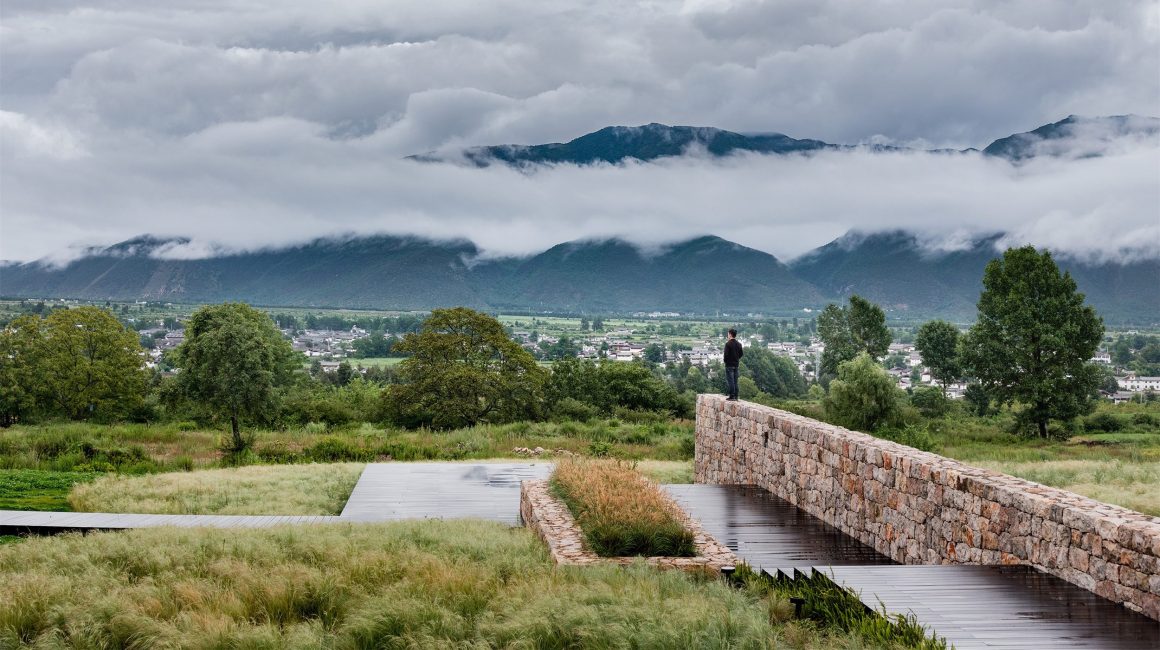
▼项目视频 Video
地处泛喜马拉雅地区,HYLLA高山花园北临玉湖古村,西靠文海,东望白沙古镇,海拔高达2560米,在终年积雪的玉龙雪山环抱中更迭四季景观。场地内资源丰富,遗存了6座院落总共35个古朴的丽江老建筑,遍地白色冰川石,果园林地交错,山鸟乱飞,满足大多数人对于自然野生的想象。
Located in the Pan-Himalayan region, HYLLA Alpine Garden sits close to Yuhu Ancient Village in the north, Wenhai in the west, and Baisha Ancient Town in the east. The altitude is as high as 2560 meters. The site is rich in resources. There are a total of 35 quaint Lijiang old buildings in 6 courtyards. There are white glacial stones, fruit gardens staggered, and mountains and birds fly randomly, satisfying most people’s imagination of natural wildness.
▼场地现状 Site situation
▼区位与总平面图 Location and master plan
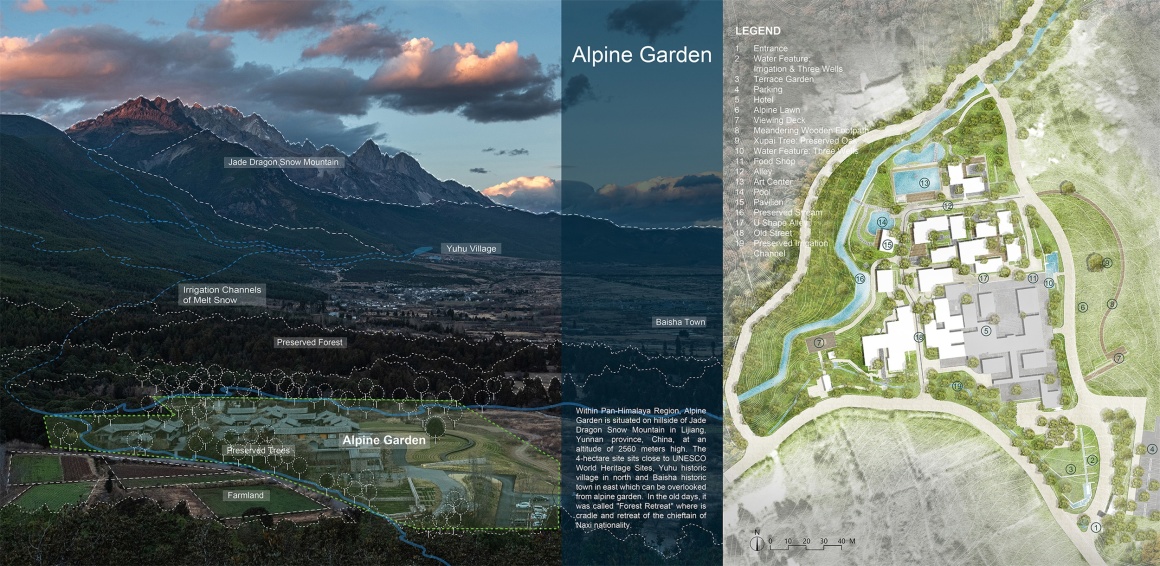
▼冬季“日照金山”下的HYLLA高山花园 Hylla Alpine Garden in winter, illuminated by golden sunlight.
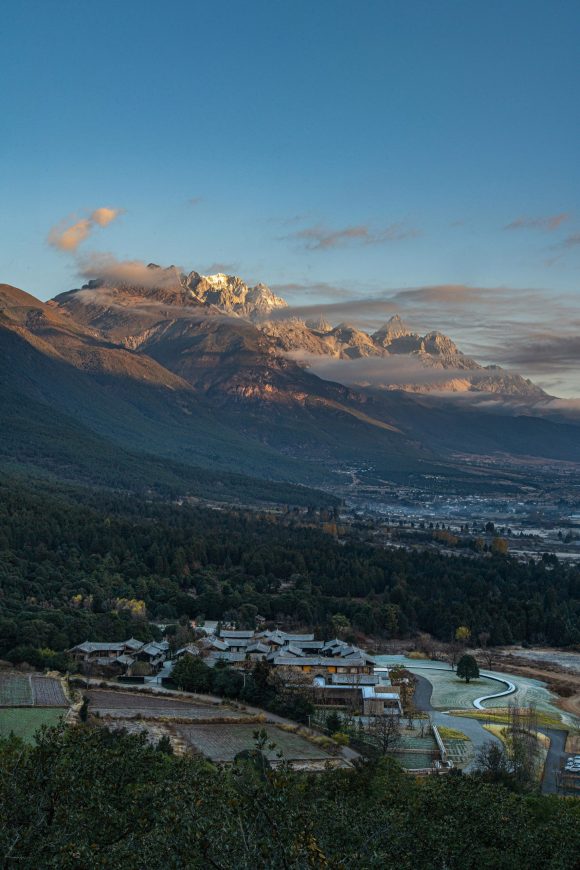
由于丽江区域存在1500米的海拔落差,HYLLA高山花园拥有从高山植物到亚热带植物独一无二的生态多样性。这里也是珍稀植物、极小种群玉龙杓兰的故乡,花园旨在留存与保护泛喜马拉雅地区具有高原特色的植物植被,将自然视为创造者,珍惜每一件她所创造的天然艺术品。
Due to the 1,500-meter drop in the Lijiang area, HYLLA Alpine Garden has unique ecological diversity from alpine plants to subtropical plants. This is also the hometown of rare plants and extremely small populations of Jade Drago Cypripedium. The garden aims to preserve and protect the plateau-characteristic vegetation of the Pan-Himalayan region, regard nature as its creator, and cherish every piece of natural artwork she creates.
▼原生态高原植被 Original ecological plateau-characteristic vegetation.
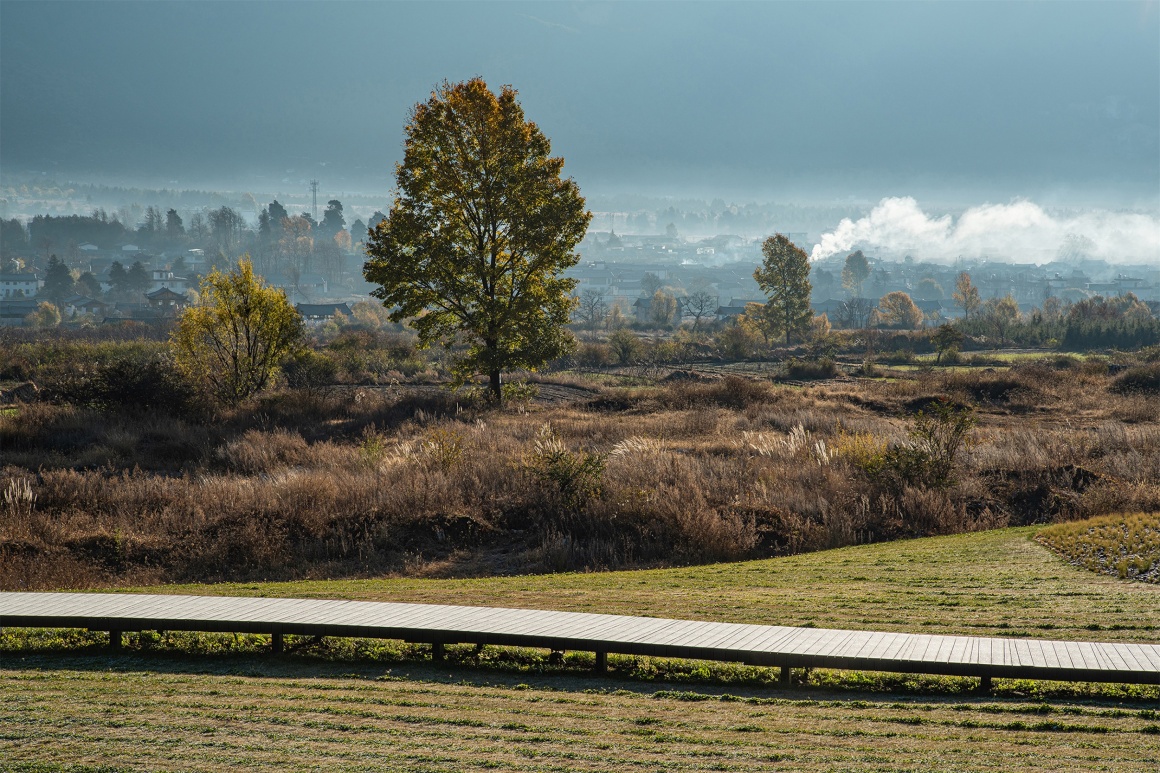
▼入口体现植物的多样性 The diversity of plants at the entrance.
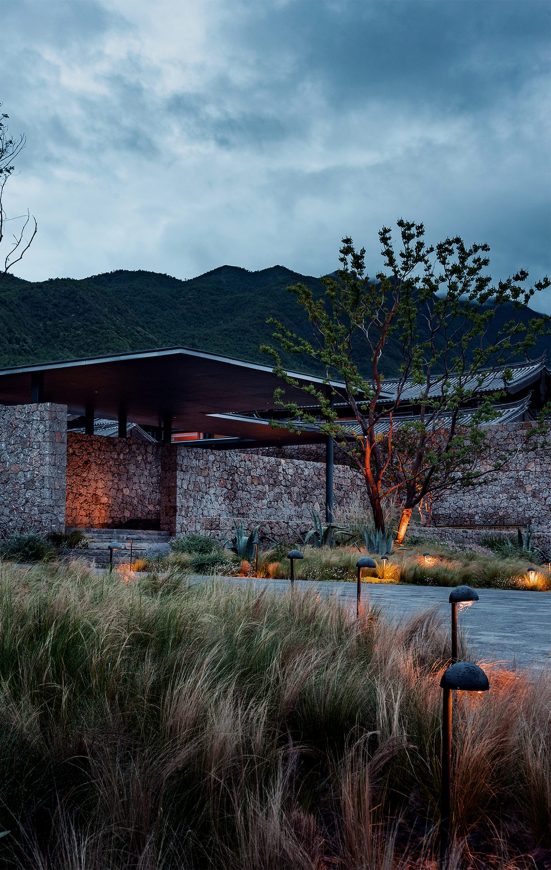
这里钟灵毓秀,偏安一隅的纳西族人自古热情好客,欢迎着八方来客。崇祯十二年(1639年),收到土司木增的邀请,徐霞客不远万里来到丽江,在解脱林(现今HYLLA高山花园所在地)与其会面,煮茶论天下。徐霞客赞叹壮丽的雪山风光和独特的纳西风景,动容地在《徐霞客游记》中记录下“坞盘水曲,田畴环焉。中有溪自东山出,灌溉田畴更广”,“乔松连幄,颇绕烟霞之气”的纳西地域景观,让丽江自然和人文风景美名迅速传遍至全国。
Here is a beautiful place, and the Naxi people have been warm and hospitable since ancient times, welcoming visitors from all directions. In 1639, upon receiving the invitation of Tusi Mu Zeng, Xu Xiake traveled a long distance to Lijiang, met with him in Jietuolin (now the location of HYLLA Alpine Garden). Xu Xiake admired the magnificent scenery of Jade Dragon Snow mountains and the unique Naxi scenery. The Naxi regional landscape quickly spread the reputation of Lijiang’s natural and cultural scenery throughout the country.
▼鸟瞰图 Aerial view
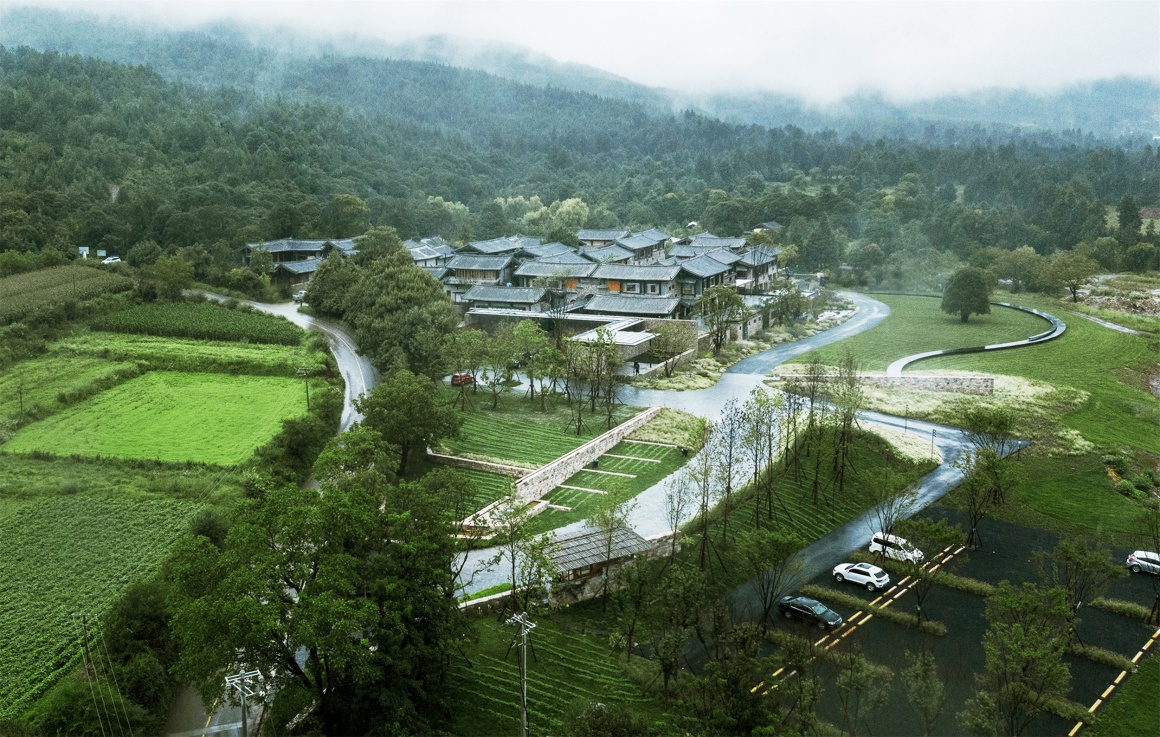
这里既是云南高山植物的故乡也是纳西族人的故乡,因此“在地性”是此次景观设计最重要的命题。通过将古老的纳西文化和现代设计语言相融合,花园成为一个重要的教育和互动的景观场所,以展示纳西园林传统的重要性,本土植物,丰富的当地石材和新的空间体验。它也是丽江欣赏冰雪覆盖的玉龙雪山和俯瞰白沙古镇的最佳场所。
This is not only the hometown of Yunnan’s alpine plants but also the hometown of the Naxi people, so “locality” is the most important proposition of this landscape design. By combining ancient Naxi culture with modern design language, the garden becomes an important educational and interactive landscape place to showcase the importance of Naxi garden traditions, native plants, rich local stone and new spatial experience. It is also the best place in Lijiang to appreciate the snow-covered Jade Dragon Snow Mountain and overlook the ancient town of Baisha.
▼俯瞰充满温情与人间烟火的白沙古镇 Overlooking the ancient town of Baisha.
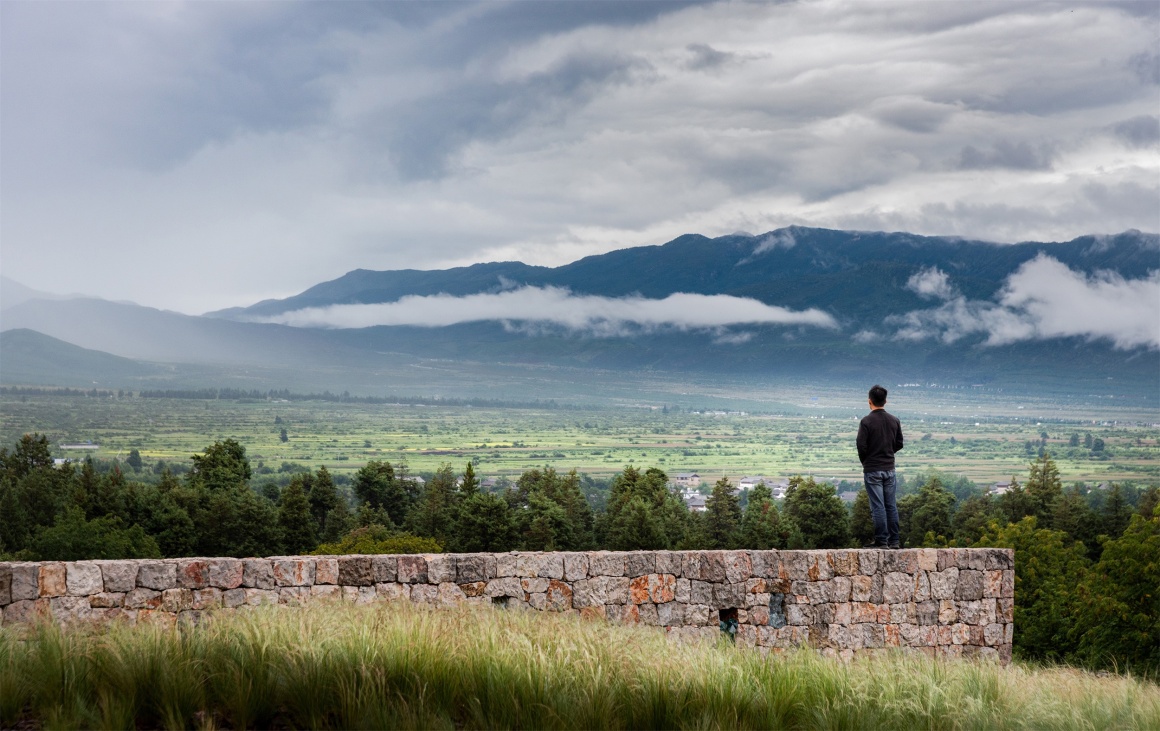
▼远眺玉龙雪山 The Jade Dragon Snow Mountain

▼墙体与远山的虚实结合 The canal wall is combined with the void and reality of distant mountains
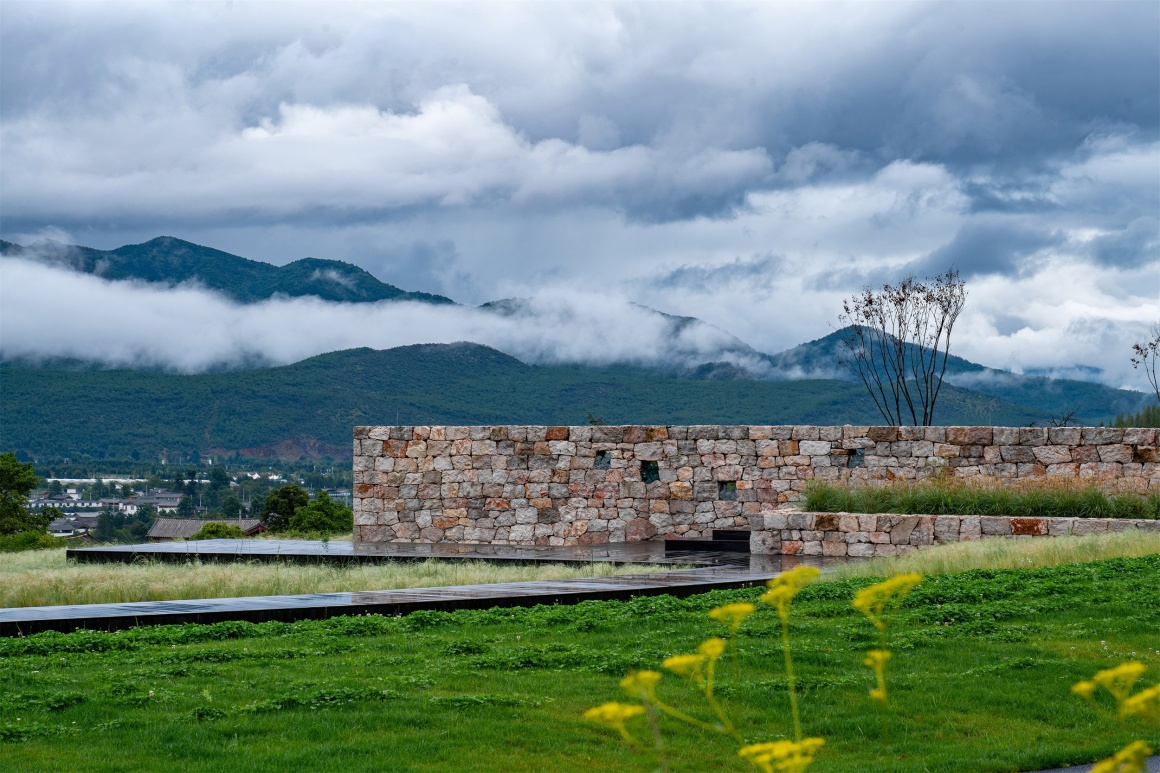
▼细节图 Details of the figure
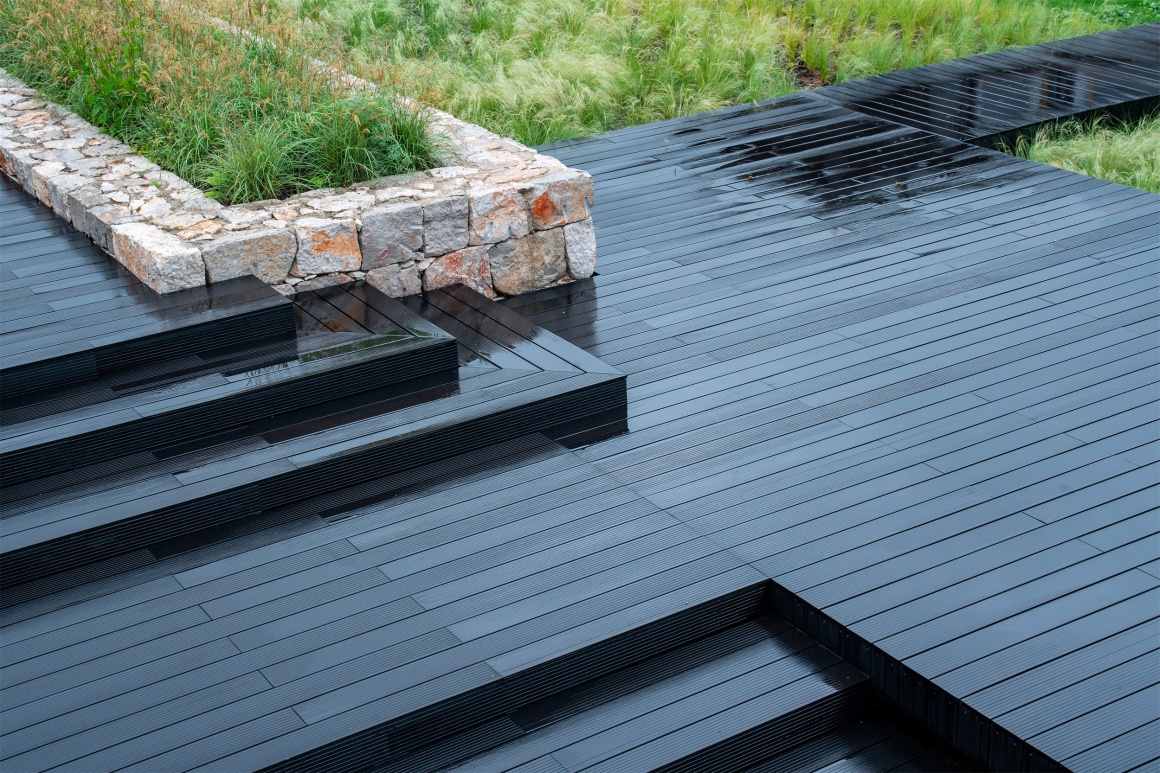
高山花园的石|The stone in the alpine garden
一座石头城,半部丽江史。“石代表人类远祖美利董阿普,心目中的胜利神,保护全氏族的安宁” – 《纳西族早期民居》。石头在纳西族人心中占据着神圣的地位。
“A stone town, half of Lijiang’s history “The stone represents the distant ancestor of mankind Meili Dong Apu, the god of victory, protecting the peace of the whole clan”-《Early Houses of the Naxi Nationality》. Stone occupies a sacred place in the hearts of Naxi people.
▼场地原貌 Site situation.

项目之初,我们考察了毗邻高山花园的玉湖村,看到家家户户竞相以各式各样的当地石头作为原料搭建自己理想的家园,千百年后的今天,形成了一座古老的石头城:有黄色的砂岩,白色的冰川石,红色的贵峰红,多彩的五花石,黝黑的黑山石等。世代居住于山脚下白沙镇里的石匠,祖祖辈辈以为周围村子的村民盖砌新石屋作为营生,是他们雕刻出丽江民居“三坊一照壁”的空间结构和质朴之美。让我们格外欣喜的是:从村民处得知本地石头的来源,全部墙体和部分铺地材料皆可从丽江采购而来,丰富且在地;墙体都是交由当地石匠以改良后的传统工艺垒砌。于是,高山花园的石头有了来源石匠也有了着落。
At the beginning of the project, we visited Yuhu Village, which is adjacent to the Alpine Garden, and saw that every family build their ideal homes using various local stones as raw materials: yellow sandstone, white glacial stone, red Guifeng stone, colorful Wuhua stone, black Heishan stone and so on. The villagers built new stone houses for their livelihoods. They carved out the spatial structure and simple beauty of the traditional houses in Lijiang. What makes us happy is that we learned from the villagers that the source of the local stones, all the walls and some of the paving materials can be purchased from Lijiang; the walls are all improved by the local stonemason traditional craftsmanship. As a result, the stone of the alpine garden had a local source, and local stonemasons were hired.
▼玉湖石头村和纳西居民 Yuhu Stone Village and Naxi residents
▼施工过程记录 Construction process
▼墙体由改良后的传统工艺垒砌 The walls are all improved by the local stonemason traditional craftsmanship
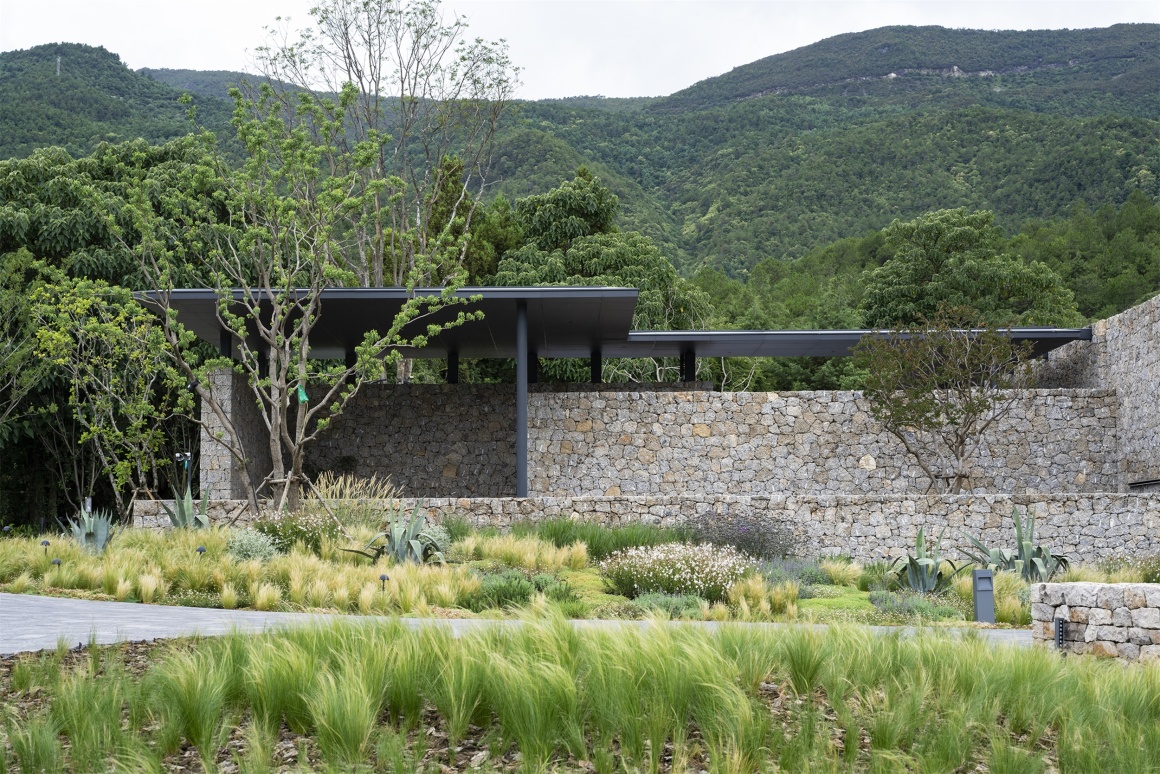
▼丽江的石在景观元素中的应用-水渠底部的黑山石与丽江红石 The application of Lijiang’s stone in landscape elements: Black Stone and Lijiang Redstone

在高山花园的施工中,是当地的石匠和木匠以其惊叹的技艺完成了所有与石头和木材有关的工程。他们采用传统工艺雕刻、堆砌,每一块石头上都刻意保留着所有细微的纹理细节,形式现代而简约。它向到访者传达了一个明确的信息:高山花园与丽江纳西文化有着紧密的联系,有着自己的独特性。
During the construction, it is the local stonemasons and carpenters who have completed all stone and wood-related projects with their amazing skills. They used traditional craftsmanship to carve and pile up, each stone deliberately retains all the subtle texture details, and the form is modern and simple. It conveyed a clear message to visitors: Alpine garden is closely related to Lijiang Naxi culture and has it own uniqueness.
▼艺术馆梨花盛开时 A view of pear blossoms at the Art Museum
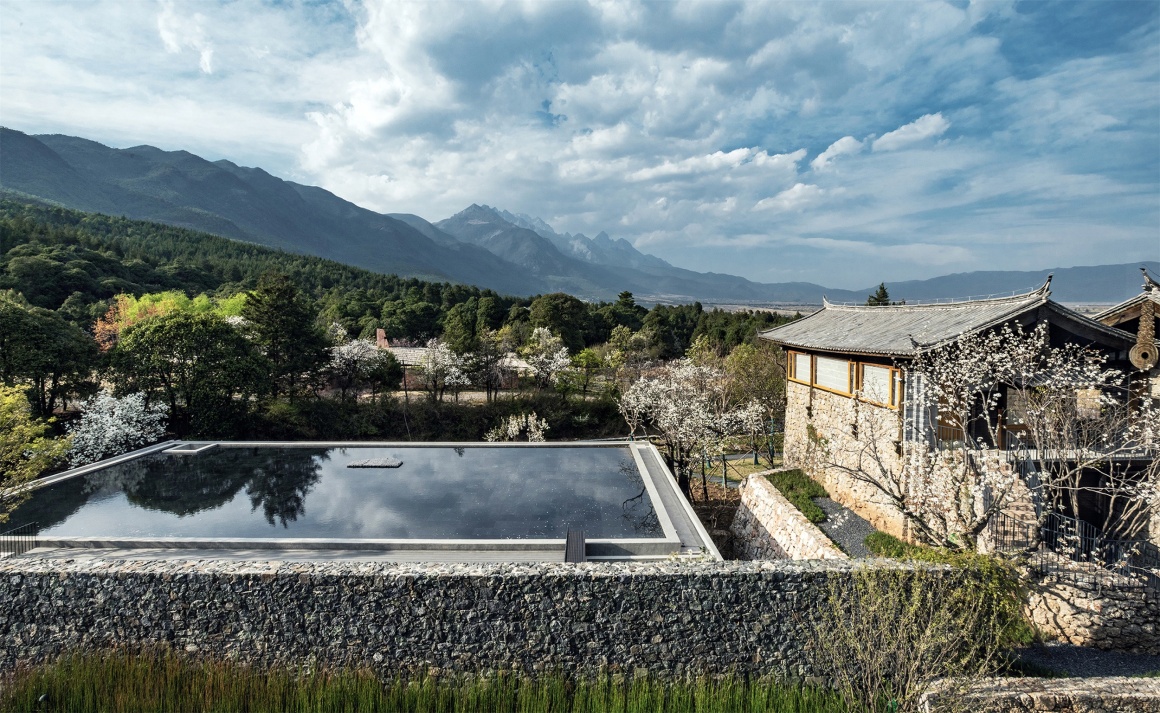
▼庭院 The courtyard

▼花园中围墙石材的运用 The use of stone in the garden wall
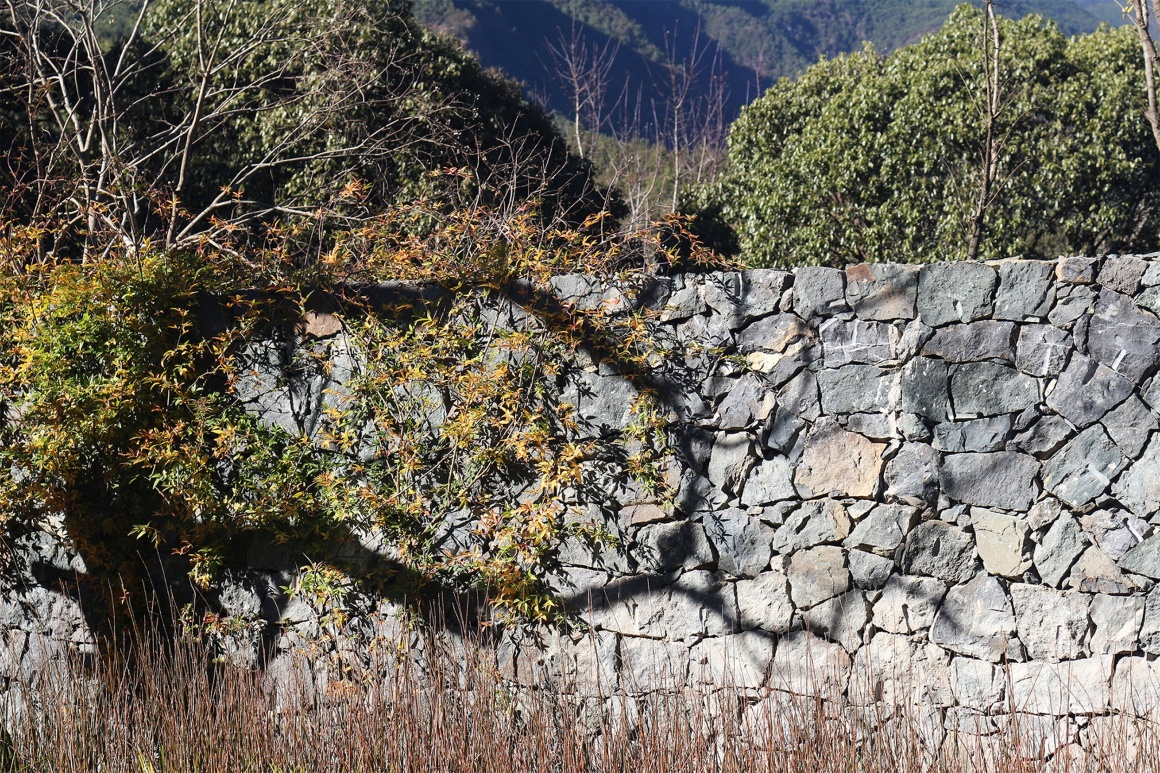
高山花园的植物|The planting in the alpine garden
丽江植物缤纷各异,在20世纪初吸引了一大批前来采集植物标本的外国探险家:汉德尔·马泽蒂(奥地利),金敦·沃德(英国),乔治·福雷斯特(英国),约瑟夫·洛克(美国)等。数百年后,在HYLLA高山花园的附近,建起了中科院高山植物园研究所,为中国和世界的植物学家提供了更好的研究环境,同时也让我们在高山花园的设计工作中意识到本土植被保护和发扬的重要性。
Plants in Lijiang are colorful and diverse, and in the early 20th century they attracted a large number of foreign explorers who came to collect plant specimens: Handel Mazzetti (Austria), Kingtown Ward (UK), George Forrest ( United Kingdom), Joseph Locke (United States), etc. Hundreds of years later, the Institute of Alpine Botanical Gardens of the Chinese Academy of Sciences was built near the HYLLA Alpine Garden, which provided a better research environment for botanists in China and the world, and made us aware of the design work of the Alpine Garden. The importance of the protection and development of native vegetation.
▼秋景 Autumn scenery
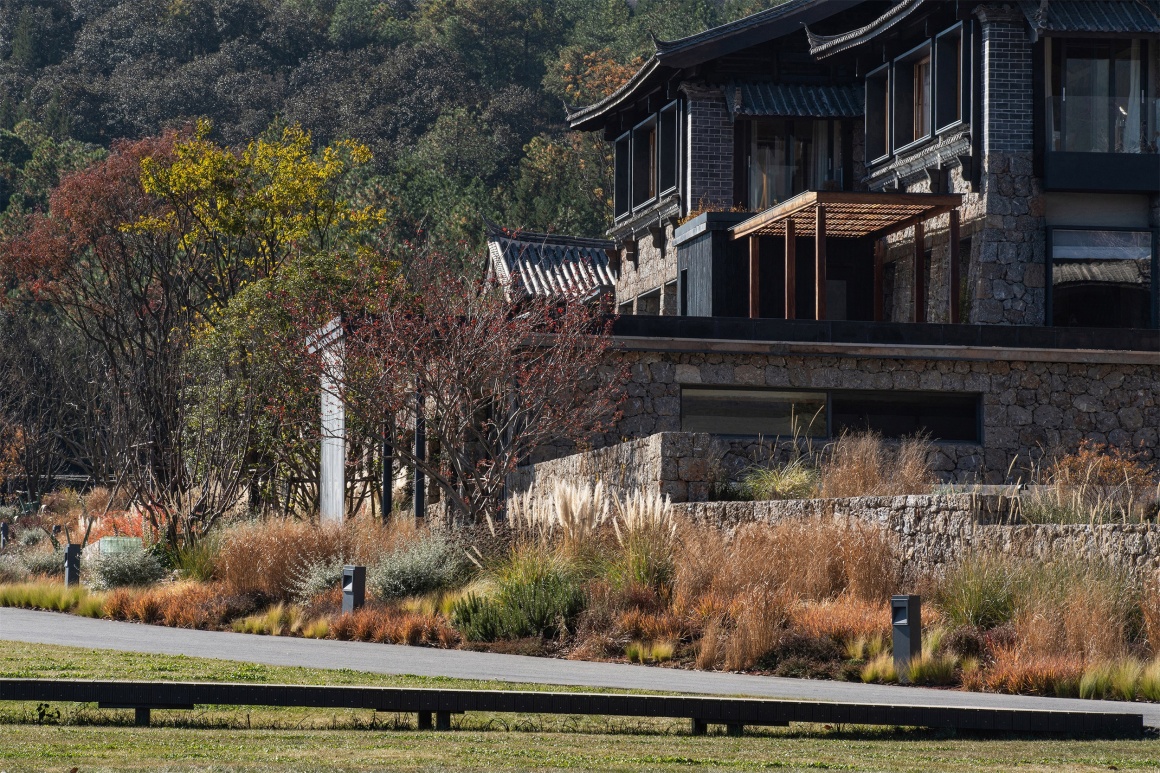
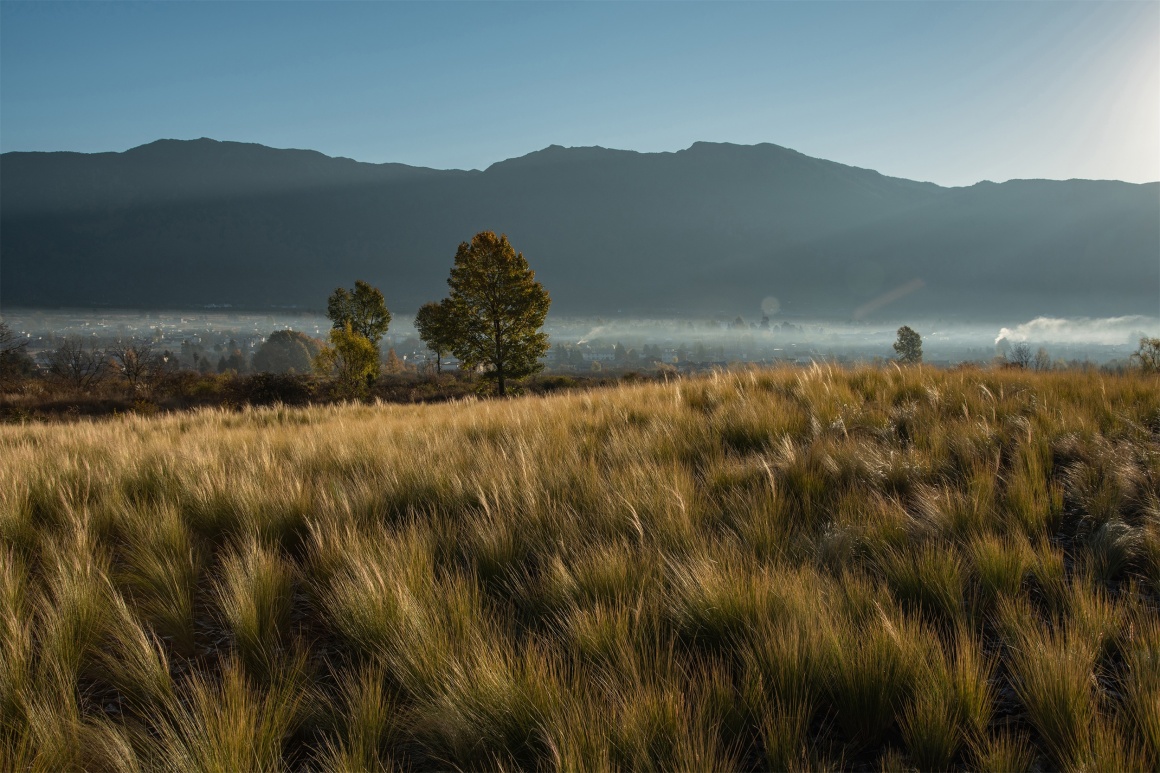
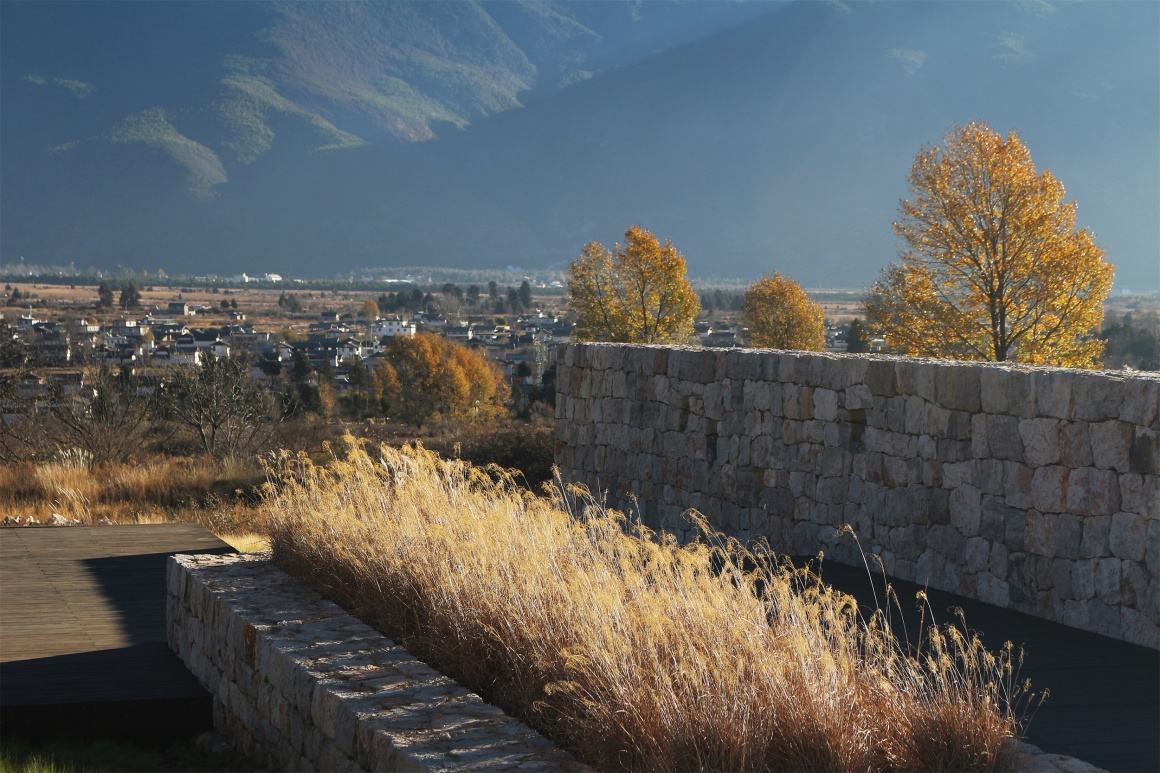
▼植物的多样性 Plant diversity
相传每个纳西村落都是围绕一颗四季常青的“许拍”而建立,“许拍”因其常青的生命力与似花非花的果实被奉为沟通神灵的象征。纳西人围着一棵树,生长建造家园,让自然力量渗透并世代守护这片土地;纳西人崇拜树木希望人的生命和生活能像树木一样繁盛兴旺。
According to legend, every Naxi village is built around an evergreen “Xupai”, which is regarded as a symbol of communication gods due to its evergreen vitality and fruit that resembles flowers. The Naxi people surround a tree to grow and build their homes, allowing natural forces to penetrate and protect this land for generations; the Naxi people worship trees and hope that human life and life can prosper like trees.
▼原生的“许拍”树 Keep the original “Xu Pai” tree
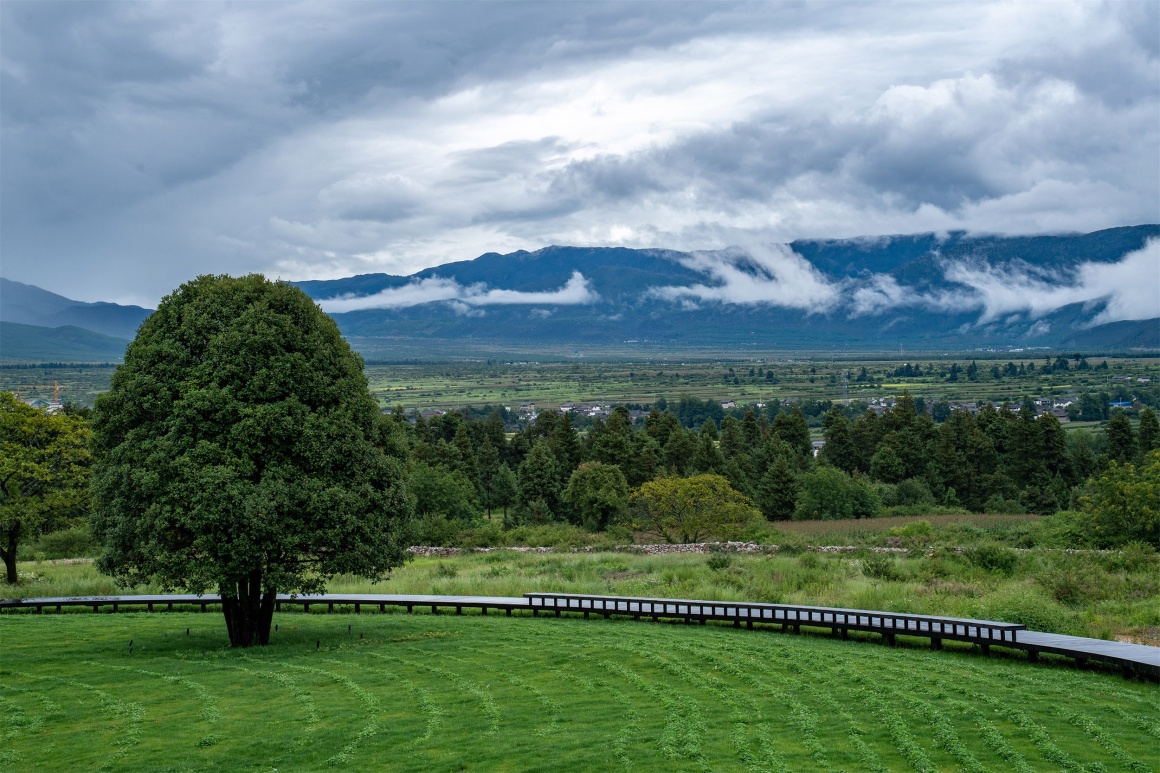
栎树是纳西族的生命之树,上古遗训说:“哪里有栎树,就可以在那里住下来。在这“解脱林”的土地上, 就保留有一棵巨大的“许拍”树,栖息在此近百年。她是颗拥有八根粗壮的分枝,枝繁叶茂,四季常青的栎树。她孤独地伫立于原始的旷野场地上,默默地守护着周围的一切。设计团队尽一切可能保证了她不受影响,并将其作为视觉焦点与精神标致,将新旧景观无缝融合,创造出具有纳西文化属性的景观。到访者可以从一堵长长的白色石墙开始行走,然后踏上一条蜿蜒曲折的黑色木栈道,沉浸在旷野雄伟的美与超然的宁静当中。蜿蜒的小径引导游客穿过一个特色的高山草坪,草坪上无数根三叶草形成的脊线是对周围麦田肌理的隐喻,是对当地农田环境的艺术回应。以许拍为中心的高山草坪,成为人们欣赏舞蹈、唱歌、阅读、观赏和聚会的活动场所,也是欣赏玉龙雪山、俯瞰白沙历史名城的最佳之处。
The oak tree is the tree of life of the Naxi people. The ancient legacy said: “Where there is an oak tree, you can live there. In this “liberation forest” land, there is a huge “Xupai” tree for habitation. Here for hundreds of years. She is an oak tree with eight sturdy branches and evergreen all year round. She stands alone on the pristine wilderness site, silently guarding everything around her. The design team do everything possible to ensure that she is not affected, and use it as a visual focus and spiritual icon, seamlessly integrating the old and new landscapes to create a landscape with Naxi cultural attributes. Visitors can start from a long white stone wall Walk, and then set foot on a winding black wooden path, immersed in the majestic beauty and tranquility of the wilderness. The winding path guides visitors through a characteristic alpine lawn. The ridge line formed by countless clover on the lawn is The metaphor of the surrounding wheat field texture is an artistic response to the local farmland environment. The alpine lawn centered on Xu Pai has become an activity place for people to enjoy dancing, singing, reading, watching and gathering. It is also a place to appreciate the Jade Dragon Snow Mountain and overlook the historic city of Baisha.
▼三叶草形成的麦田肌理 The texture of a wheat field formed by clover

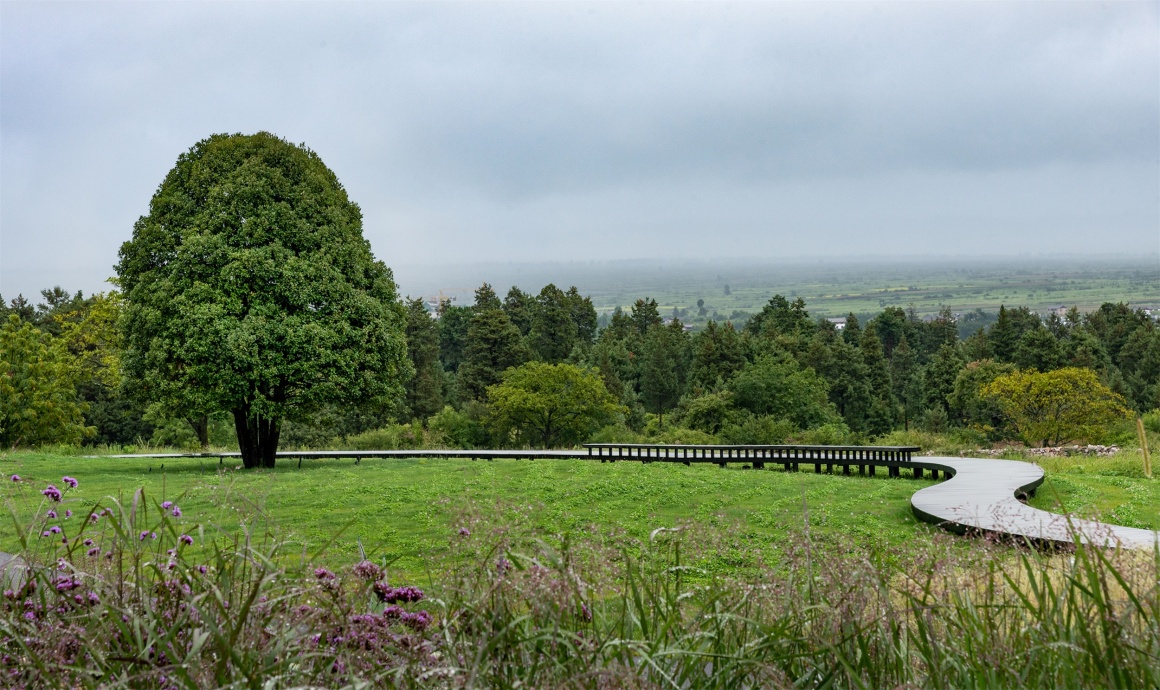
▼栈道上保留的现状树冬景 Winter scenery of the current tree preserved on the plank road
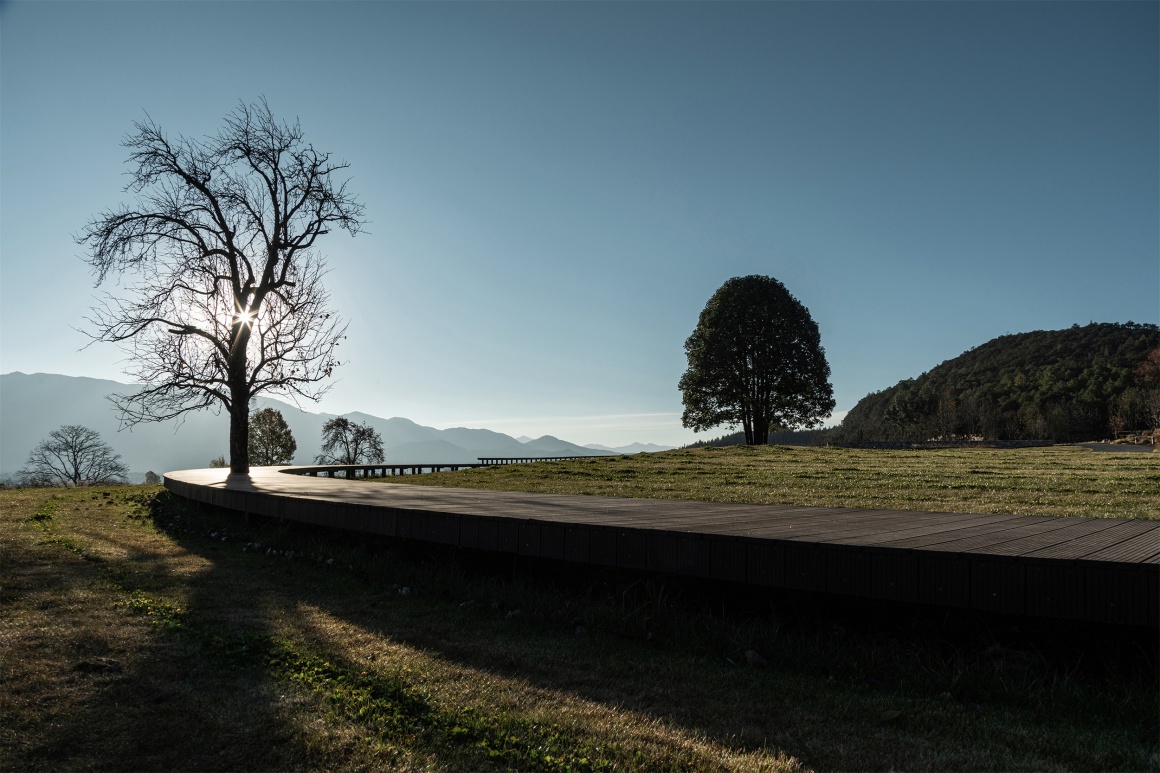
HYLLA高山花园的景观设计就是从保留原生的一颗“许拍”树开始建造了一座在大自然中寄情于物的精神境地。整体的景观设计很好的体现了少即是多的思想,以低干预的手法,语言节制的设计,将景观设计与大山大水的自然之美融合。设计手法力求简练,以“鸟鸣山更幽”来类比此处的设计逻辑。面对强大的“空”的气场,只有“鸟鸣”才能更加衬托出“空”的意境。洒满野花的草坪和一条漂浮的木栈道就是设计师设置的一声“鸟鸣”。
The landscape design of HYLLA Alpine Garden is to build a spiritual place with love and affection in nature from the preservation of the original “Xupai” tree. The overall landscape design well embodies the idea of less is more. With a low-intervention approach and language-controlled design, the landscape design is integrated with the natural beauty of the mountains and rivers. The design method strives to be concise, and the design logic here is analogous to “When bird sing, mountain are more secluded”. In the face of the powerful “empty” aura, only “birds” can bring out the “empty” artistic conception. The lawn sprinkled with wild flowers and a floating wooden plank road are the “birds singing” set by the designer.
▼鸟鸣山更幽 When bird sing, mountain are more secluded
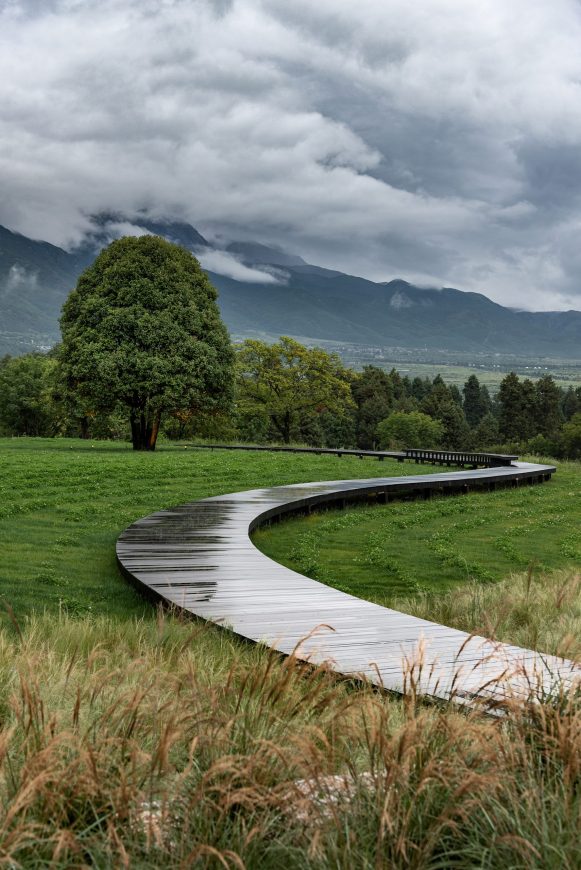
花园的西面和北面是大片的森林,由当地美丽的栎树、漆树、泡桐和美丽的野生云南松组成。为了最大程度的保护原有生态系统,业主和设计团队周全细心地考量,避免任何重型机械,以便仔细保护每一棵原生树木和地被植物的安全。本次设计也融入了高山植物如高山杜鹃、高山鸢尾、高山梨树、大戟等,以突出泛喜马拉雅地区高山生态的特殊性,保护和改善当地的生态系统,同时靠建筑附近,软景营造渐渐精细,给游客提高了景观的观赏层次和丰富性,让野生般的粗犷和出其不意的精致并存。
In the west and north of the garden is a large forest, composed of beautiful local oak trees, sumac, paulownia and beautiful wild Yunnan pine. In order to protect the original ecosystem to the greatest extent, the owner and design team carefully considered and avoided any heavy machinery. This design also incorporates alpine plants such as alpine rhododendron, alpine iris, alpine pear tree, euphorbia, etc., to highlight the particularity of the alpine ecology of the Pan-Himalayas, protect and improve the local ecosystem.
▼雨季森林 Rainy season forest
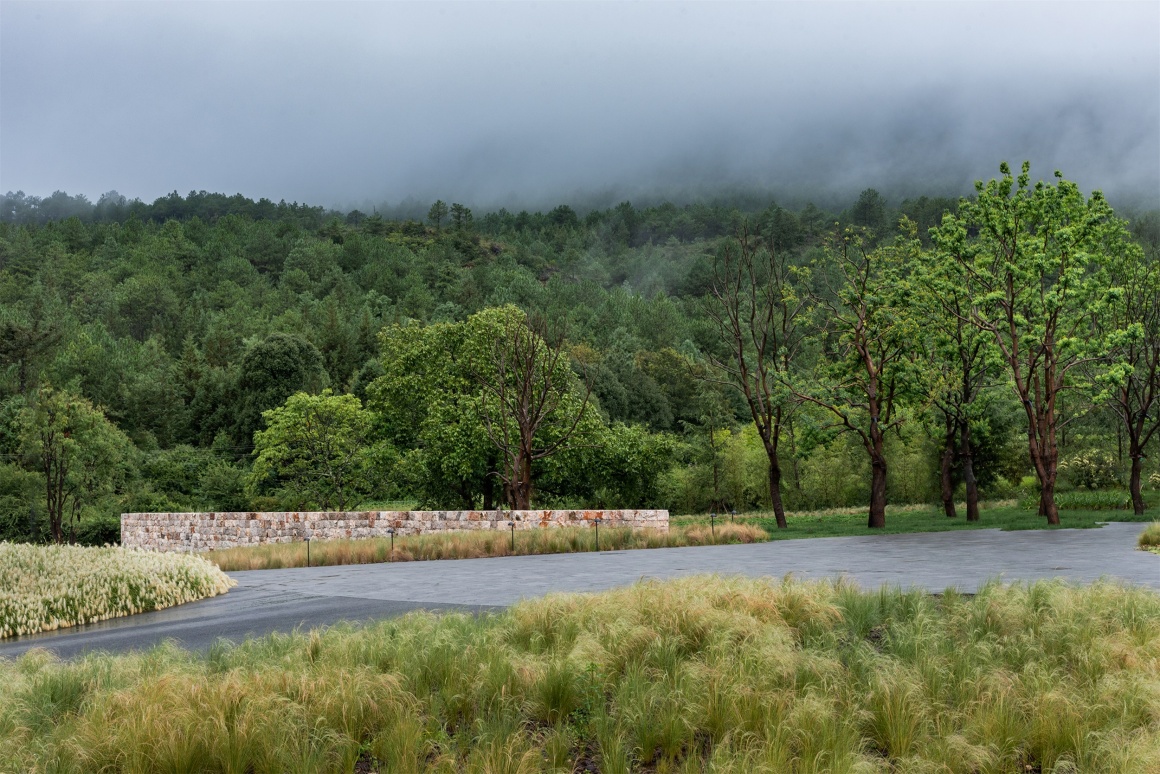

▼保留森林与花园 Reserve forests and gardens
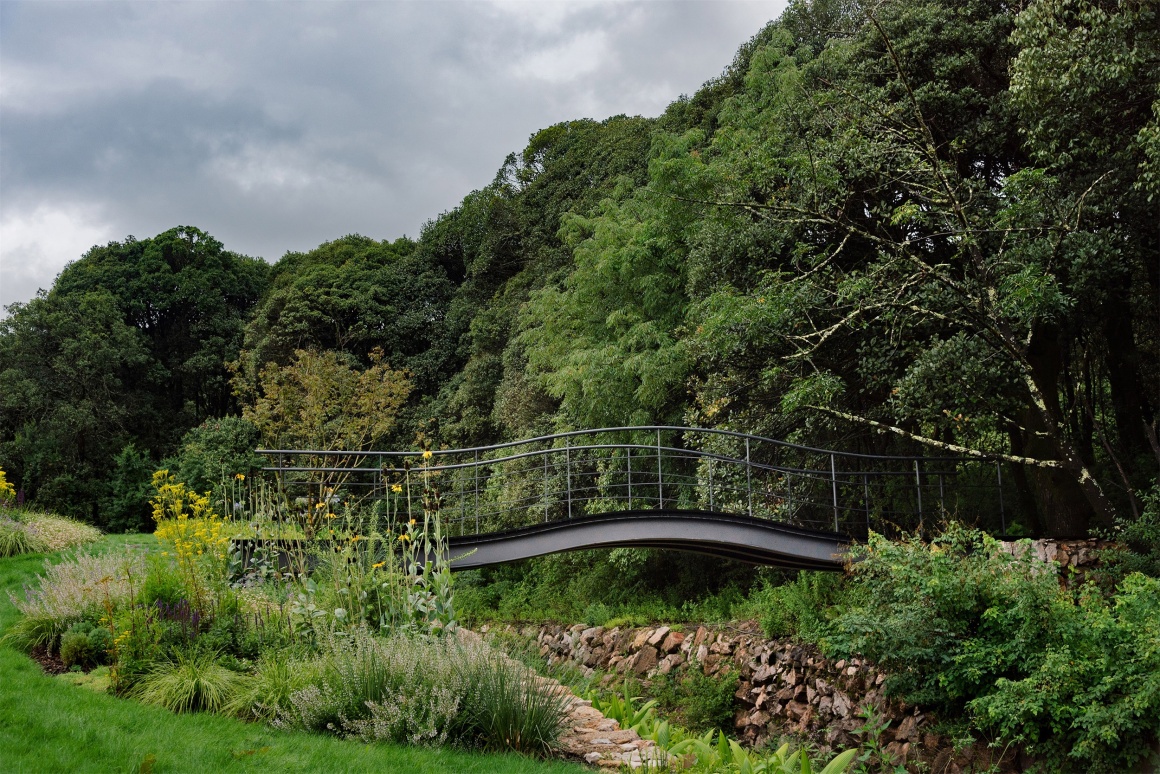
▼休憩亭平台 Recreation pavilion platform

▼林中步道 The forest trail
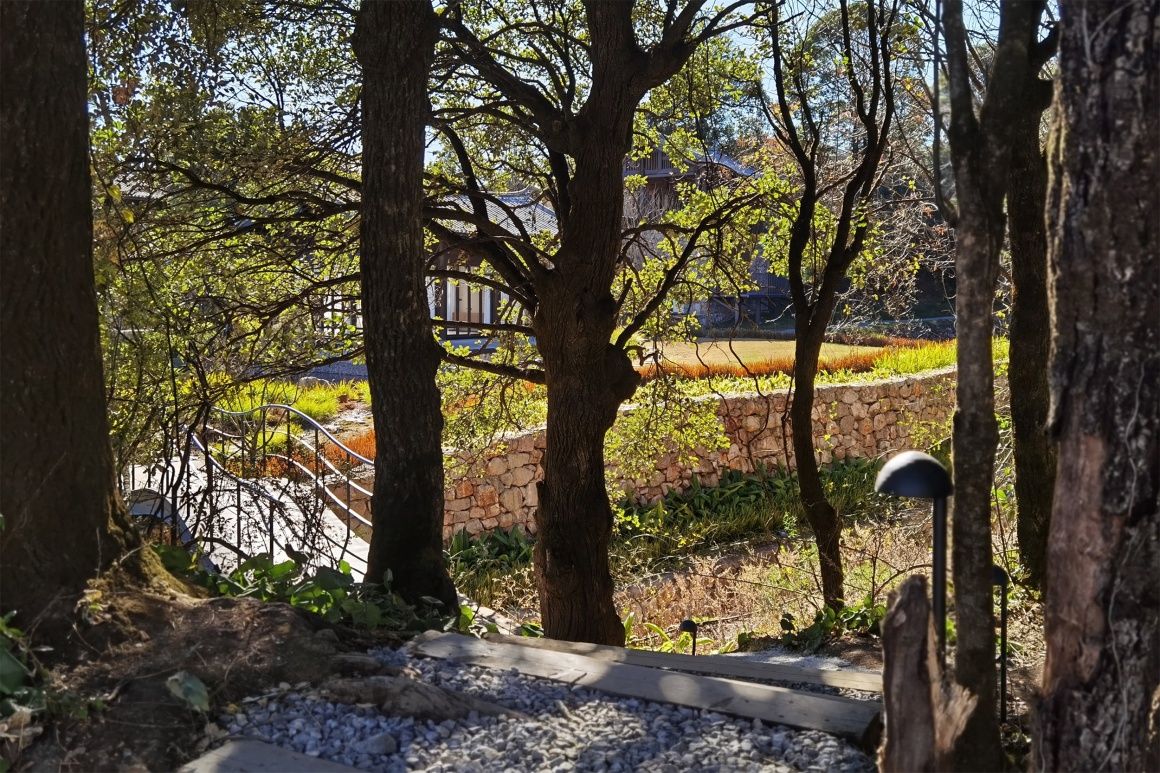
▼夜景 Night view
陌上花开,香入土,在这神奇的高山花园场地上,每天都能欣赏到流云与落英相逐的美景。高山植物,喜阳的,耐荫的;我们希望色彩是流动的,既纯粹又是戏剧化的。猫薄荷,马鞭草,千鸟花,迷迭香,马连草、柳叶星河……团团簇簇,缤纷浪漫的自然分布在建筑下沿,惹得蜂蝶飞舞,鸟语叽喳,四处花木竞香。
The flowers bloom on the field. In this magical alpine garden, you can enjoy the beautiful scenery of flowing clouds and falling flower every day. Alpine plants are sunny and shade-tolerant; we want the colors to be fluid, pure and dramatic. Catnip, verbena, plover flower, rosemary, malian grass, willow galaxy… clusters, colorful and romantic nature are distributed along the lower edge of the building, causing bees and butterflies to fly, birds whispering, flowers and trees everywhere.
▼夏季景观 The summer landscape
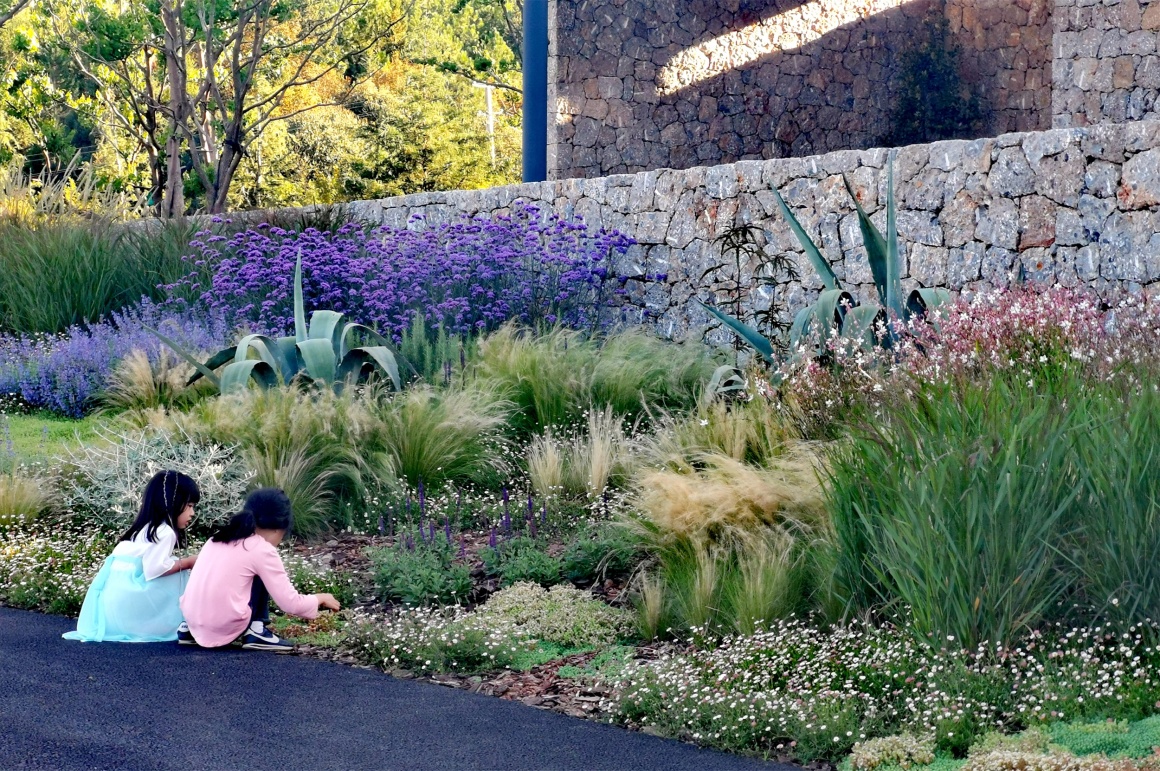
▼巷道植物 Plants of roadway
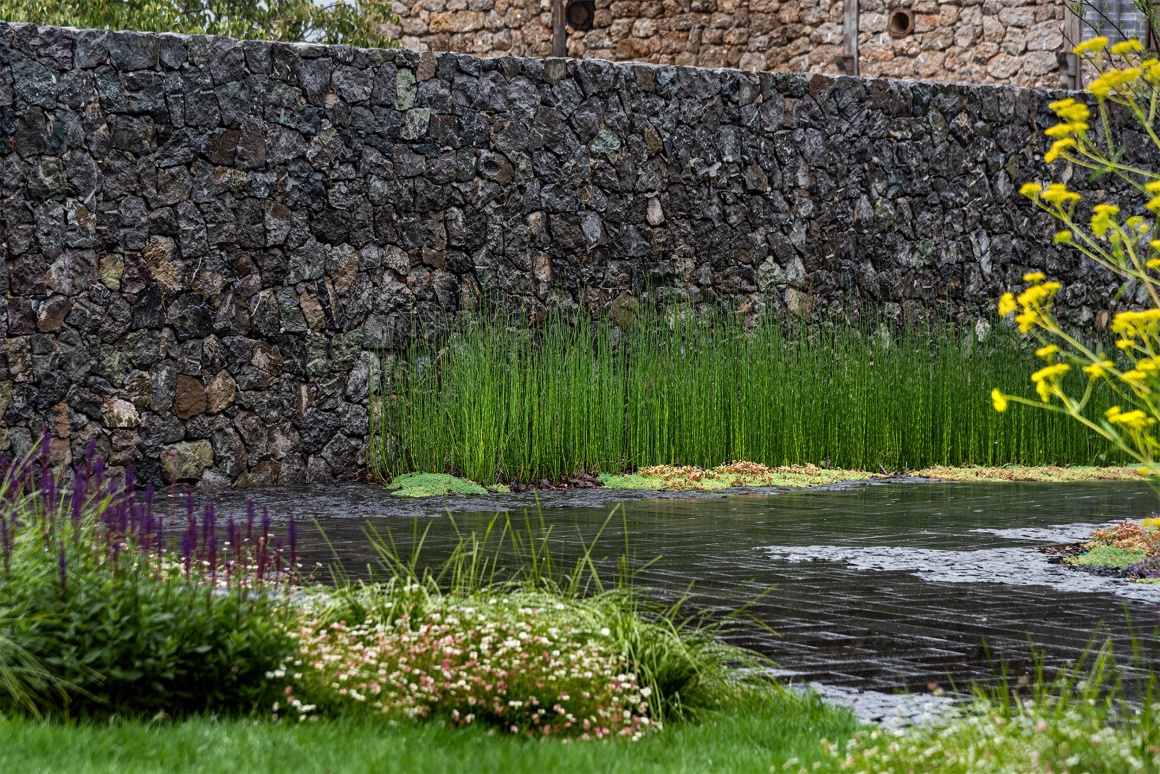
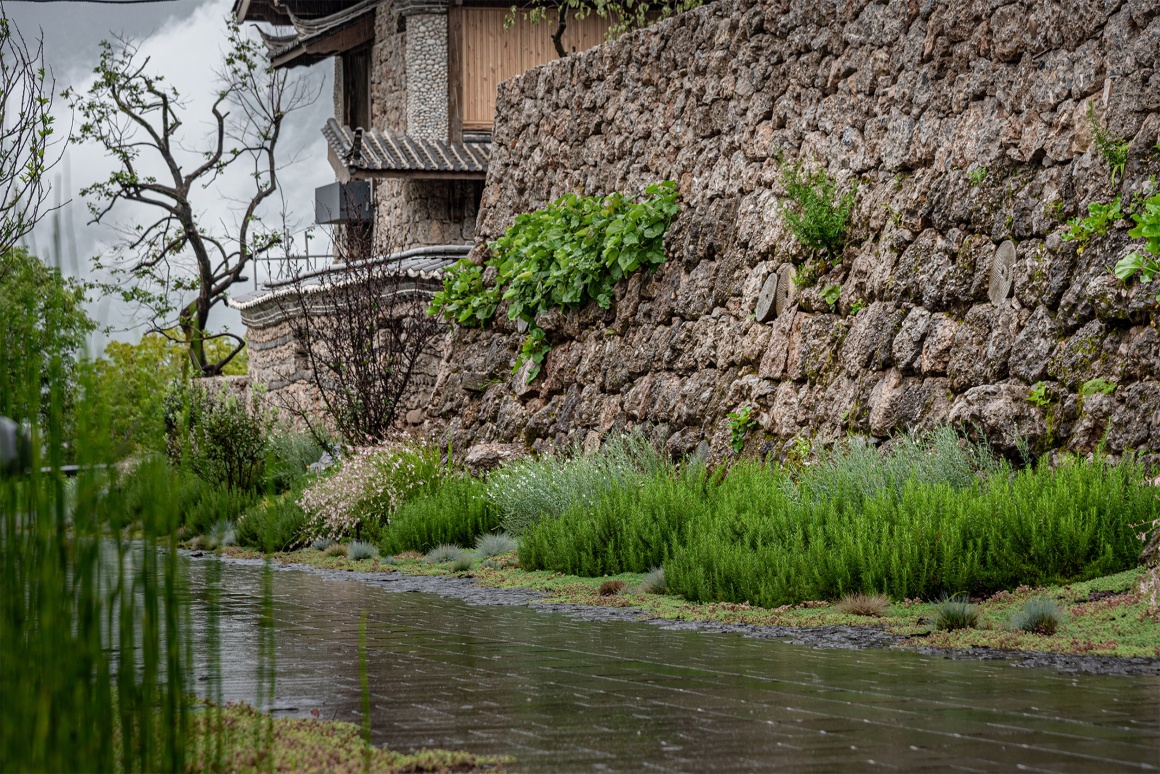
背阴的巷道处则是色彩素雅静谧的地被,中华景天,木贼草,肾蕨,蓝羊茅,接骨木,烟斗石楠等,这里以最自然最浪漫的花朵来营造轻松的闲情雅致。
The shaded lane is a quiet and elegant floor covering. Sedum sinensis, equisetum, kidney fern, blue fescue, elderberry, pipe heather, etc., here are the most natural and romantic flowers to create a relaxing and elegant atmosphere.
▼新旧融合自然生长 The old and the new grow naturally together
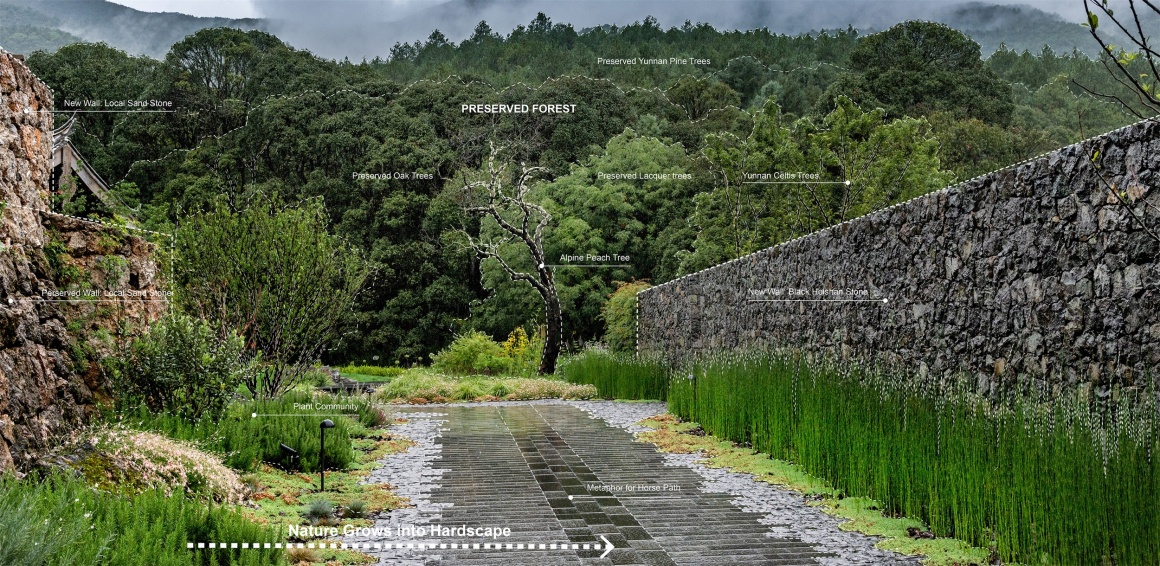
▼植物细节 Plant details
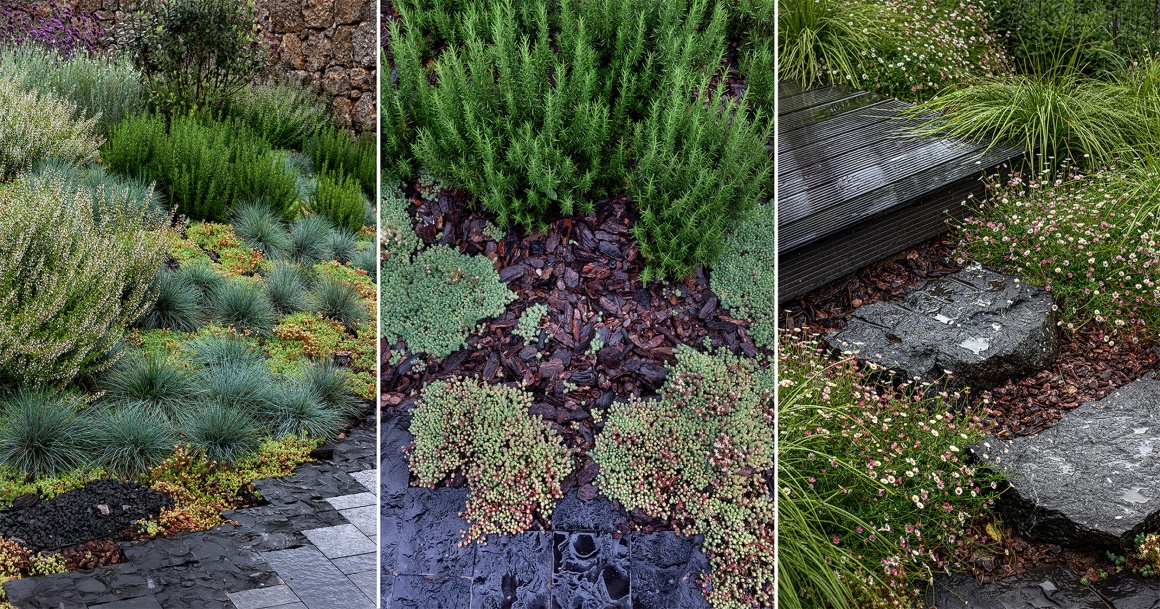
高山花园的水|The water feature in the alpine garden
活水长流,纳西人追求的水在于其灵气,和生命的奔流不息。不同于其他民族的护水、围水于家的局地化思维。在丽江,网状水系入墙绕户造就了主街傍河、小巷临水、跨河筑楼、依山而居的高原水城景象。基于场地现状,南北两条水系穿流而过,于是历史上纳西人那种自古流水相伴,聆水泉韵的生活又能延续了下来。
Living water flows for a long time. The water that Naxi people pursue is its spiritual energy and the endless flow of life. It is different from the localized thinking of protecting water and surrounding water at home in other ethnic groups. In Lijiang, the networked water system enters the walls and surrounds the households to create a plateau water city scene with rivers on the main street, waterfront alleys, buildings across the river, and living on the hillside. Based on the current situation of the site, the north and south two water systems flowed through, so in history, the Naxi people’s life of listening to the spring can continue.
▼艺术馆屋顶与静水面 Roof of Art Museum and Quiet Water
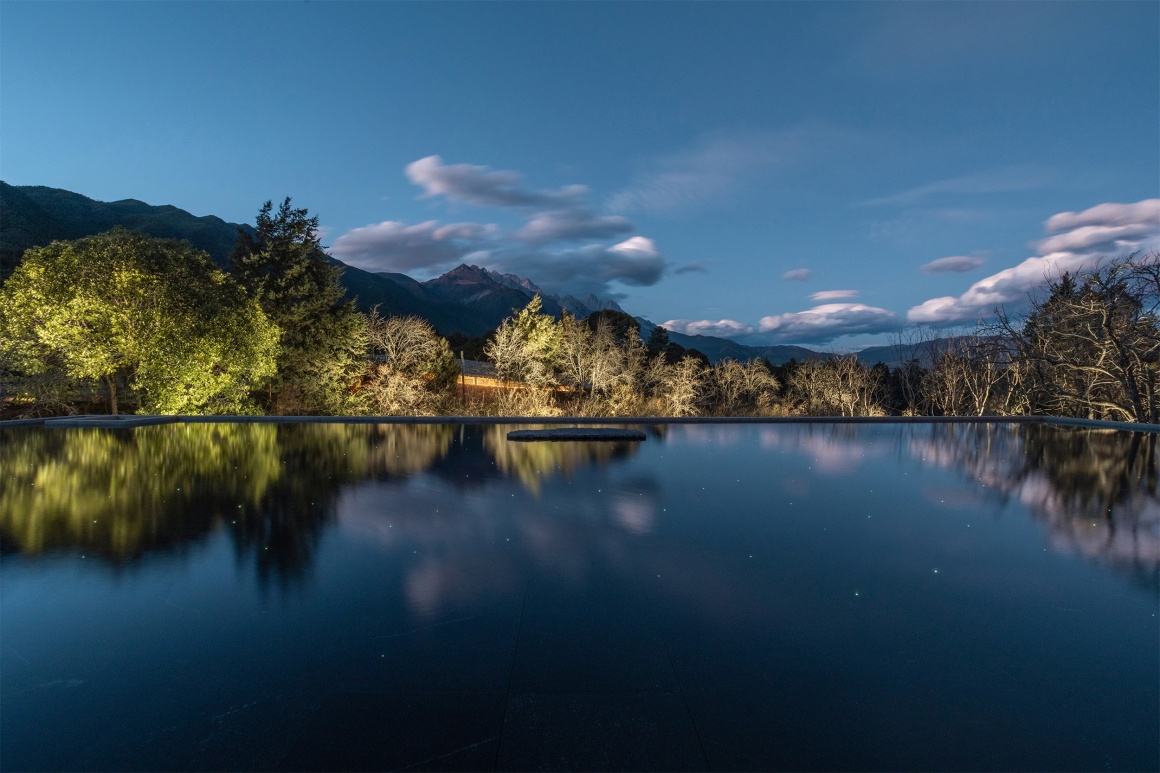
▼村民食堂前的水景 Waterscape in front of the villager’s canteen


“三眼井”代表着当地人善用活水的生活智慧,印证了纳西人对于活水的精巧利用。纳西的人居环境往往活水环绕,人们将涌出地表的水依照地势高差修成三潭蓄水,头潭为居民饮用水,第二潭用以涮洗蔬菜瓜果,第三潭作洗涤衣物只用,最后所用之水流走,灌溉农田。每每去到三眼井旁,总能亲自见证纳西人那悠久而又自然生态的生活方式,感动于他们的传统邻里关系以此为纽带得到维系。
The “three wells” represents the wisdom of the local people to make good use of living water, and confirms the Naxi people’s ingenious use of living water. The living environment in Naxi is often surrounded by living water. People will build three pools of water from the surface according to the elevation difference. The first pool is used for drinking water for residents, the second pool is used for washing vegetables and fruits, and the third pool is used for washing clothes. Finally, the used water runs away to irrigate the farmland. Every time I go to the three wells, we can witness the natural life style of the Naxi people, and are moved by their traditional neighborhood relationship.
▼三眼井及水渠的演进 The waterscape inspiration by “three wells”

▼入口水渠落水处 The falling water of the long channel at the main entrance.


三眼井的传统形式也在此次的景观设计中也得到了体现和延伸。主入口长水渠的落水和村民食堂门口的水景,皆为三重水台跌落,池底放置美丽的丽江红石和黑山石,局部以黑色板岩作为过渡。我们希望这种本土生长出来纳西文化,能够进一步植根每位到访者的心中,在地性成就唯一性,新旧融合共续未来。
The traditional form of the three wells has also been reflected and extended in landscape design. The falling water of the long channel at the main entrance and the waterscape at the entrance of the villagers’ canteen are all triple water platforms. The beautiful Lijiang red stone and black mountain stone are placed at the bottom of the pool, with black slate as a transition part. We hope that this native Naxi culture can be further rooted in the hearts of every visitor, achieving uniqueness in the locality, and merging the old and the new to continue the future.
▼入口长水渠 The long channel at the main entrance

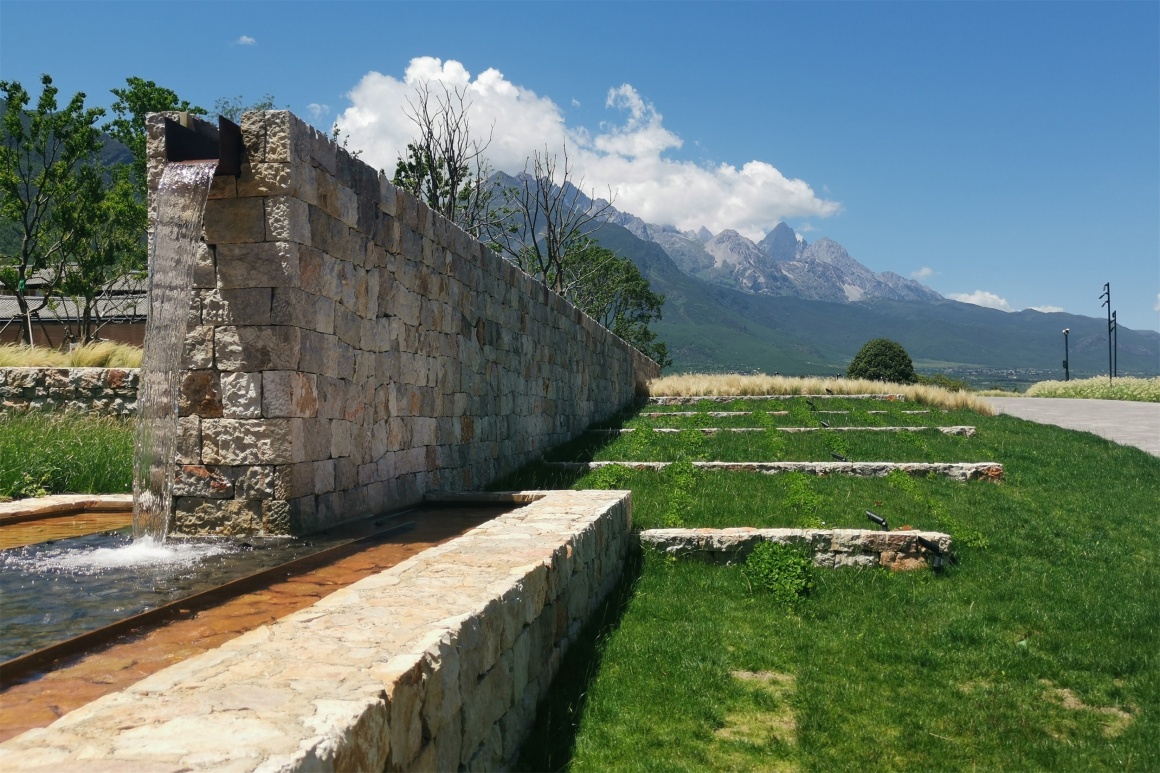
▼水渠细部 Details of the long channel
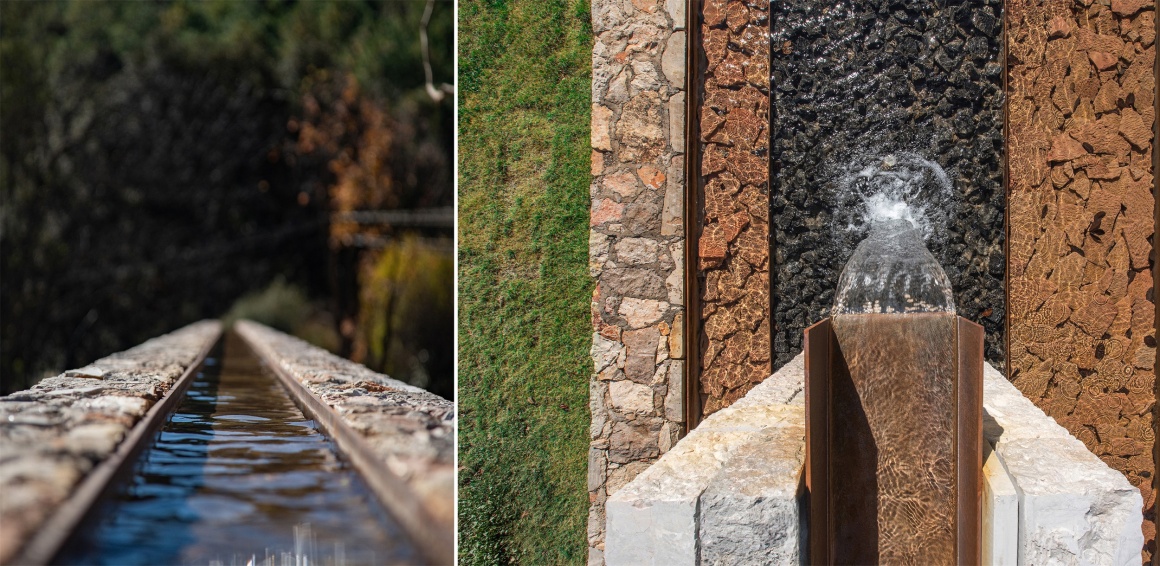
▼水渠效果图 Renderings of canals
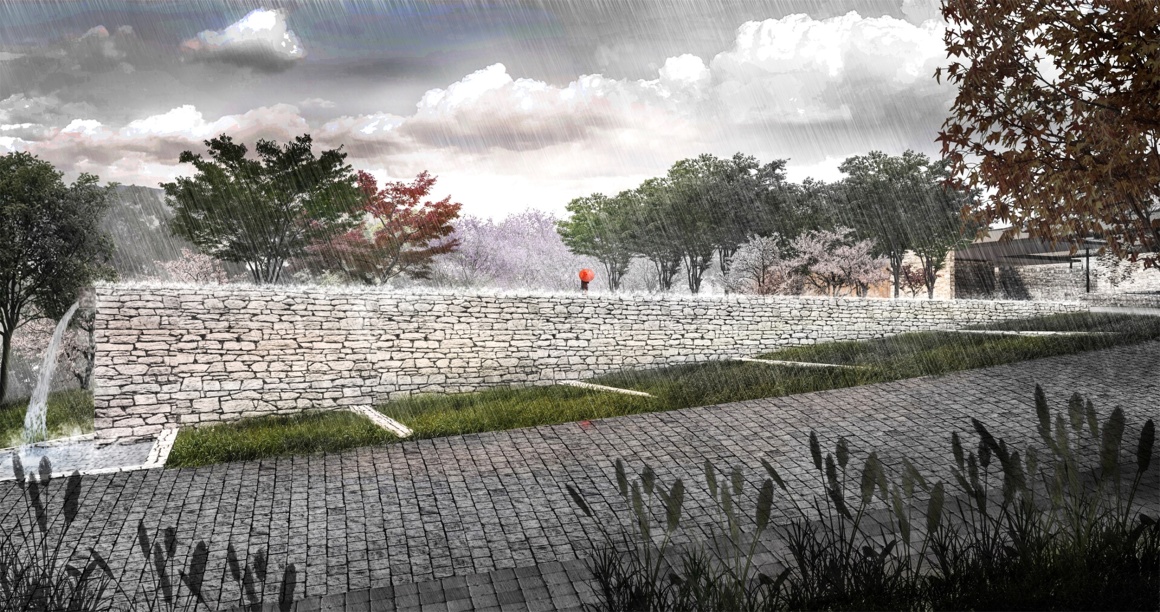
写到此,夕阳渐下,借一缕和风,手捧20世纪初俄国作家顾彼得的《被遗忘的世界》,独坐“许拍”下的长椅,面朝白沙,闲逸的揭开那尘封的历史画卷。在HYLLA高山花园,心里已默默还原了一个原生的丽江。
At this point, the setting sun is fading, with a gentle breeze, holding “The Forgotten World” by the Russian writer Gu Peter in the early 20th century, sitting alone on the bench under “Xu Pai”, facing the ancient town of Baisha, uncovering leisurely that dusty picture of history. In the HYLLA Alpine Garden, a native Lijiang has been quietly restored.

项目名称:丽江HYLLA高山花园:雪山下的自然生长
项目地址:云南省丽江市玉龙县白沙镇岩脚村99号
景观设计:Z’scape致舍景观
联系邮箱 :info@la-zscape.com
项目设计 & 完成年份:2019-2021
主创及设计团队:周梁俊、周婷、于浩、陈丽萍、侯伟光、石宏杰、刘雪婷、吕俊兴、秦芳、韩沛、孙畅、史慧婷、王子健、张秋语、杜景芝、刘月姮、杨振华、刘家琦、陈劼、张蒙、董微(实习生)、王梓岚(实习生)
业主:HYLLA 物与岚
业主团队:胡秋锦、杨飞、何巧侯
花境顾问:成都尚野园艺有限公司
景观施工:四川兴立园林环境工程有限公司
照明设计:北京周红亮照明设计有限公司
石匠:丽江财润鸿劳务工程有限公司
木作:香格里拉市红木堂古建装饰有限公司
摄影师:郑焰、 morefoto、HYLLA、栾琪、周婷、吴瑕、孙一文、周红亮、杨飞
视频拍摄及制作:morefoto
Project name :Hylla Alpine Garden
Project Location: No.99 Yanjiao Village, Lijiang, Yunnan
Design:Z’scape
Contact e-mail:info@la-zscape.com
Design year & Completion Year:2019 – 2021
Leader designer & Team:Liangjun Zhou, Ting Zhou, Hao Yu, Liping Chen, Weiguang Hou, Hongjie Shi, Xueting Liu, Junxing Lv, Fang Qin, Pei Han, Chang Sun, Huiting Shi, Zijian Wang, Qiuyu Zhang, Jingzhi Du, Yueheng Liu, Zhenhua Yang, Jiaqi Liu, Jie Chen, Meng Zhang, Wei Dong(Intern), Zilan Wang(Intern)
Client: HYLLA.
Client Coordinators: Qiujin Hu, Fei Yang, Qiaohou He
Planting Consultant: Chengdu Shangye Horticulture Co., Ltd.
Landscape Contractor: Sichuan Xingli Garden Environment Engineering Co., Ltd.
Lighting Consultant: Zhou Hongliang Lighting Design Beijing Co., Ltd.
Local Naxi Stonemasons: Lijiang Cairunhong Engineering Co., Ltd.
Local Naxi Carpenters: Shangri-La Hongmutang Traditional Wood Structure Co., Ltd.
Photo credits: Yan Zheng、morefoto、HYLLA、Qi Luan、Ting Zhou、Xia Wu、Yiwen Sun、Hongliang Zhou、Fei Yang
Vedio: morefoto
更多 Read more about: Z’scape 致舍景观


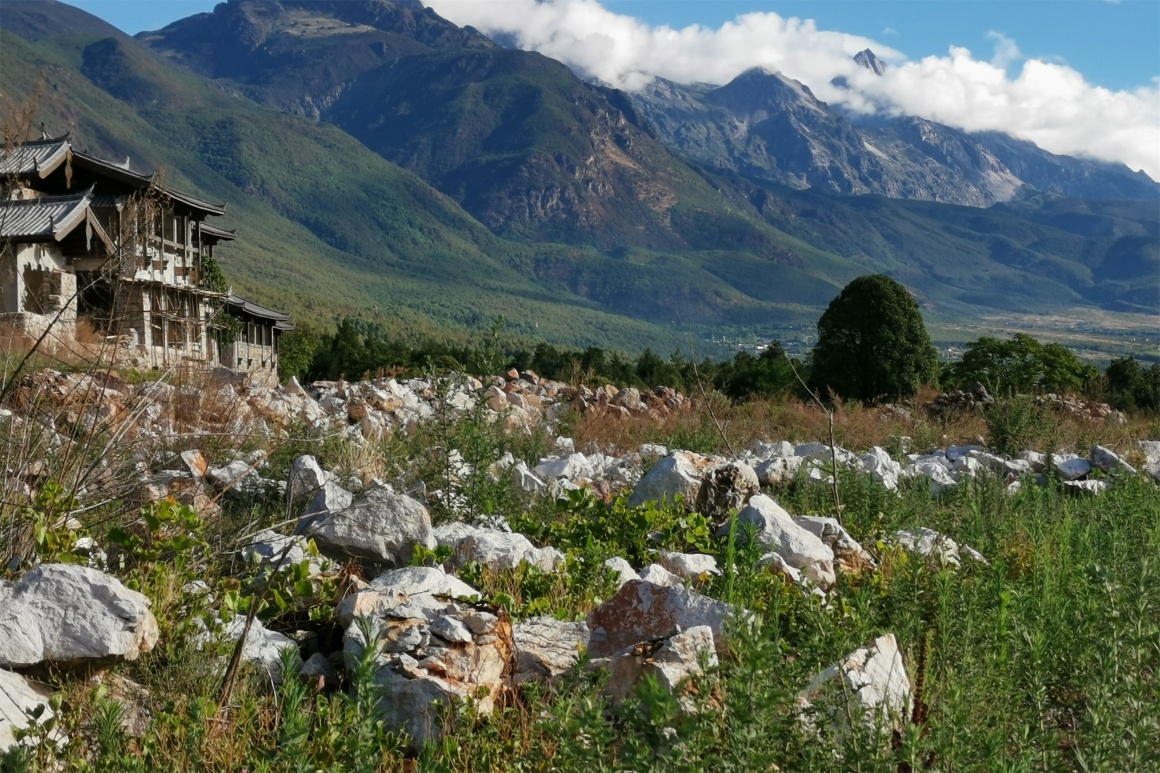
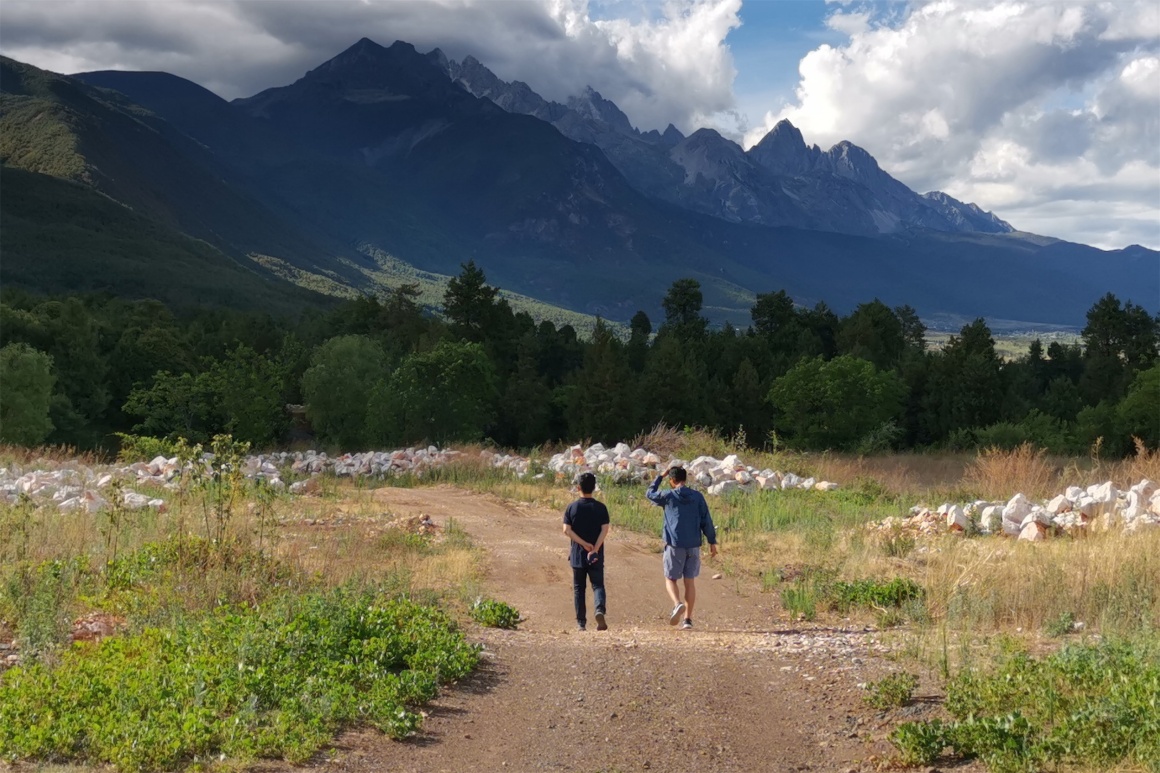
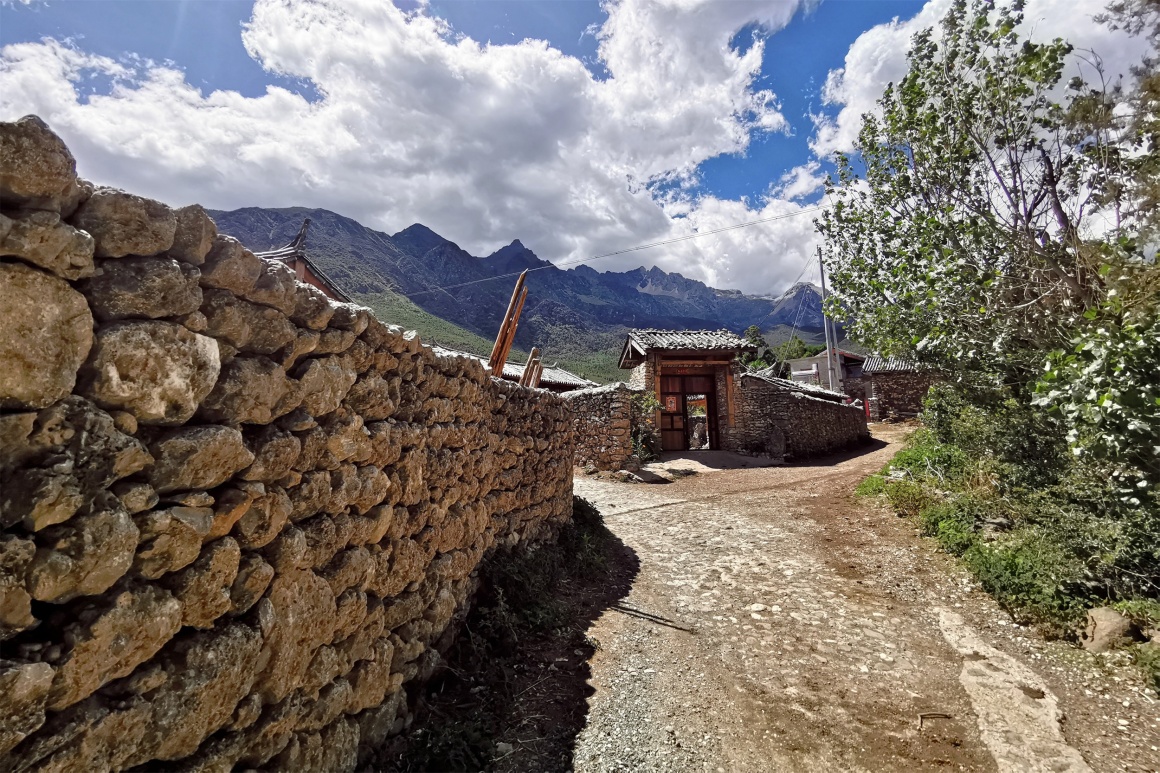
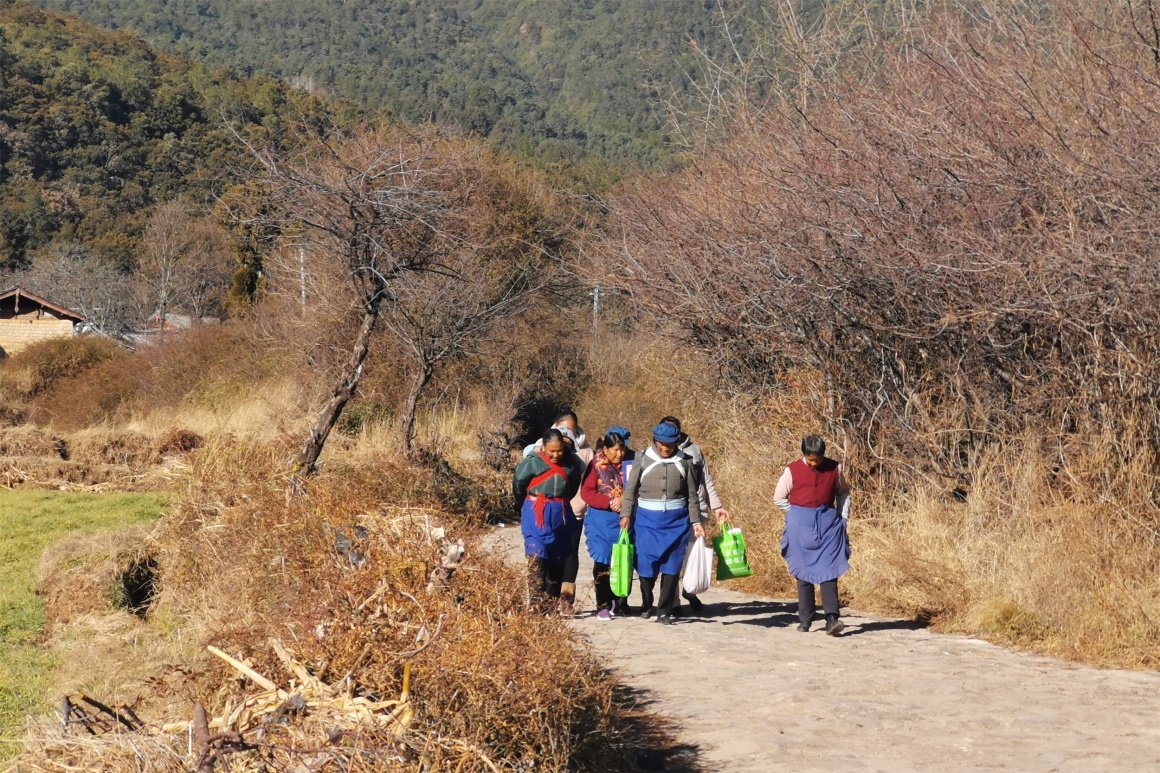
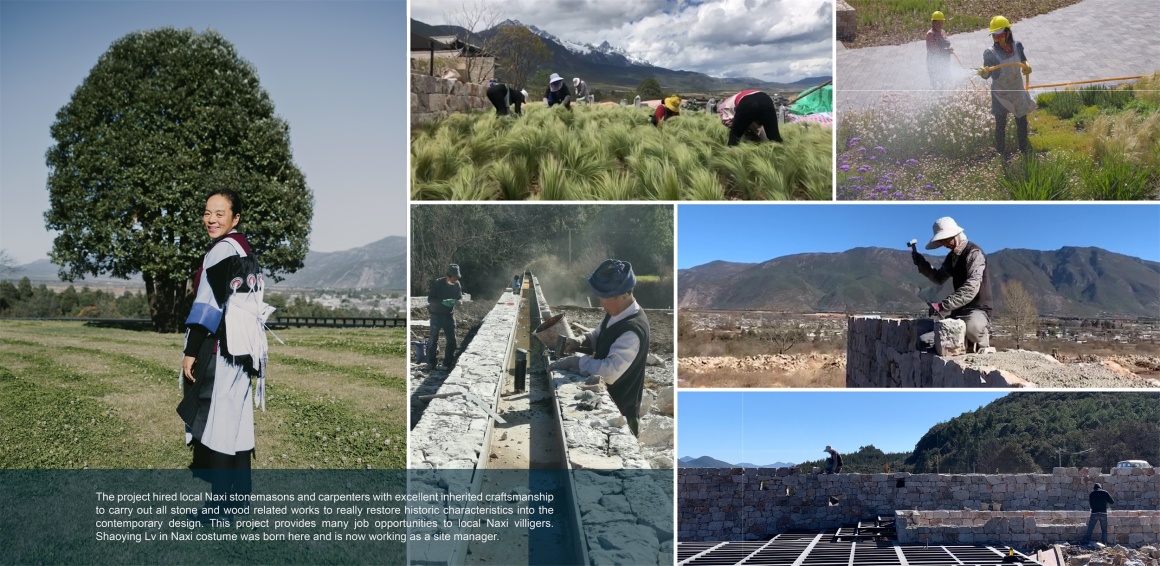
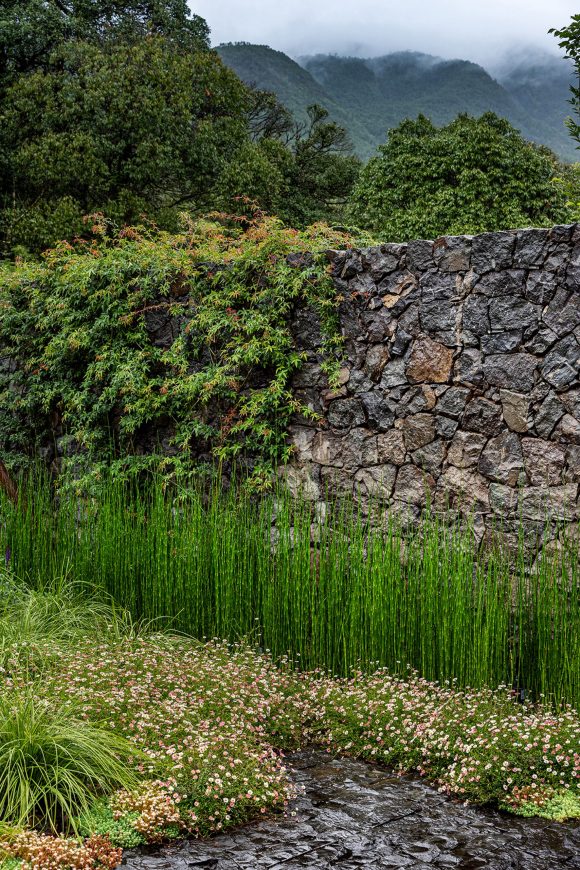
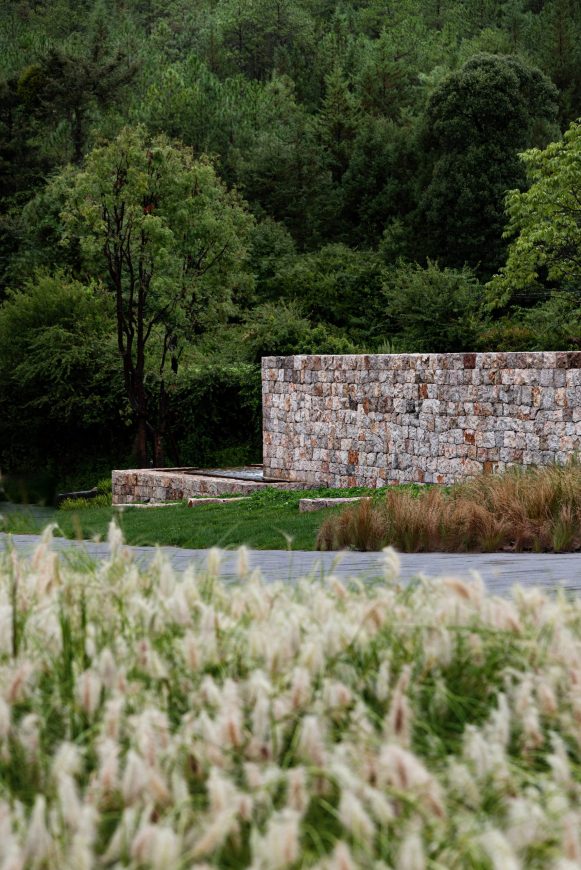
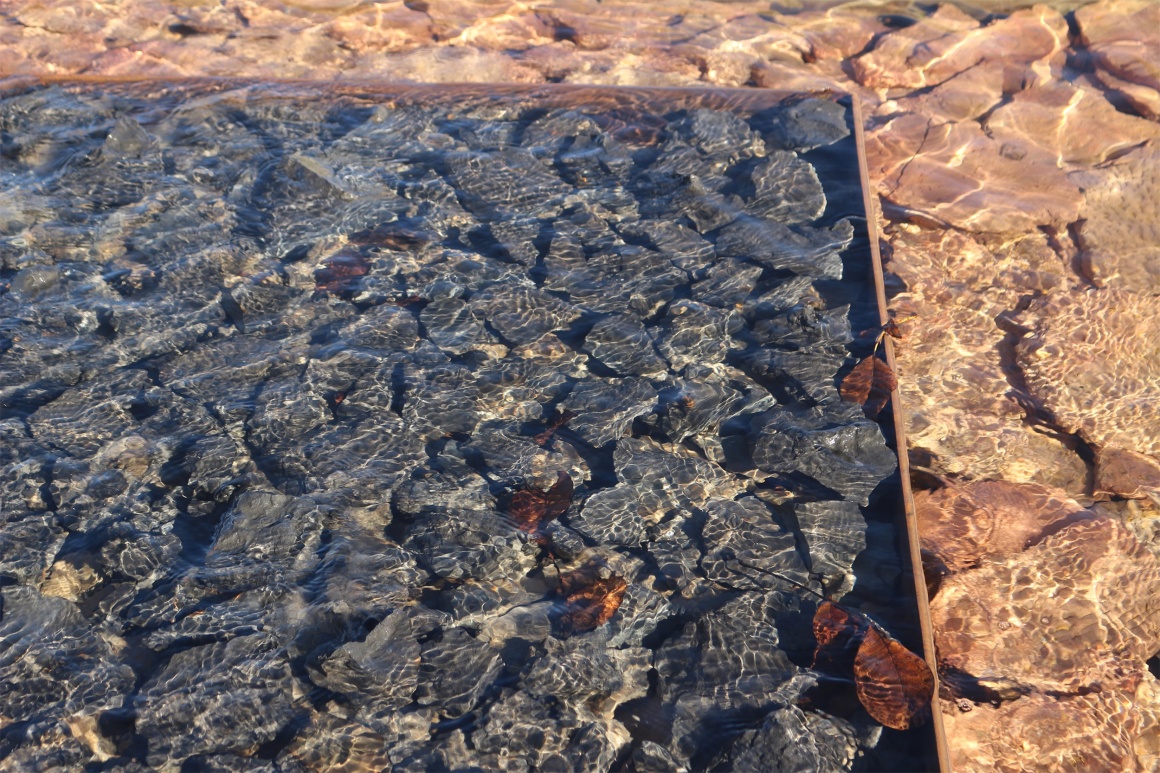
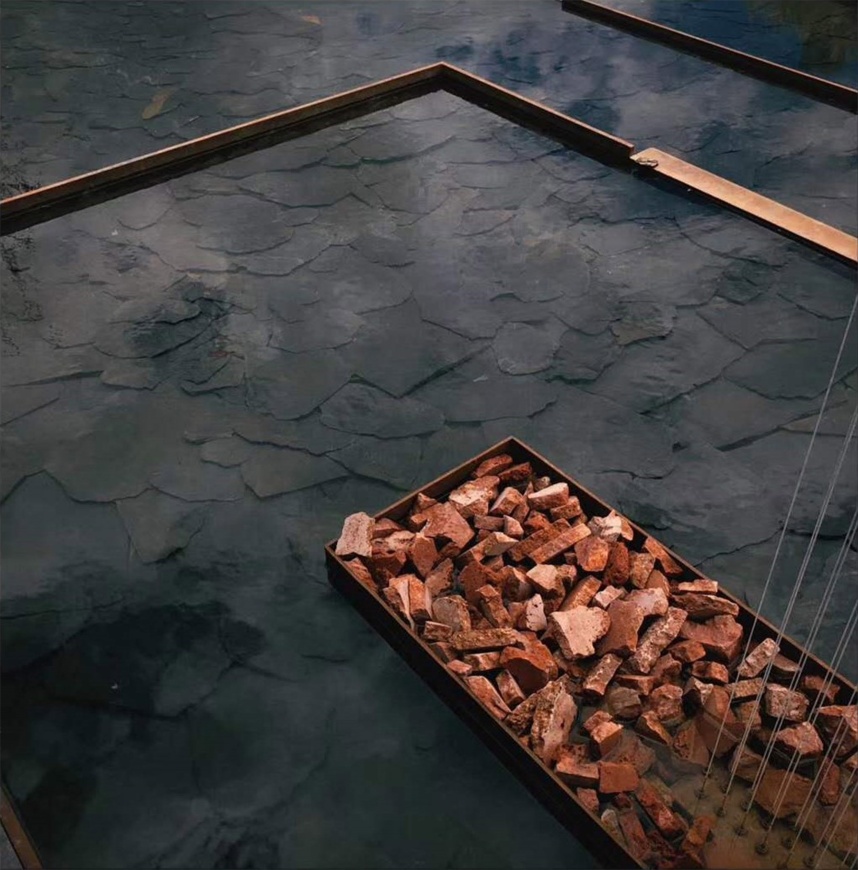

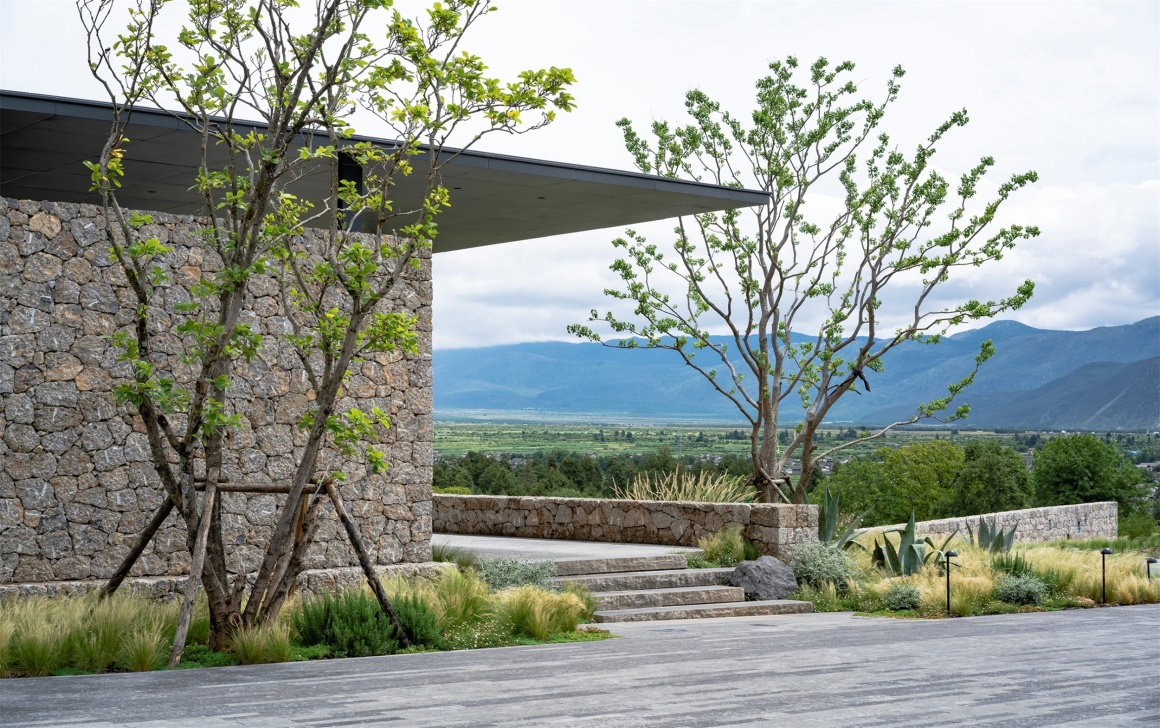

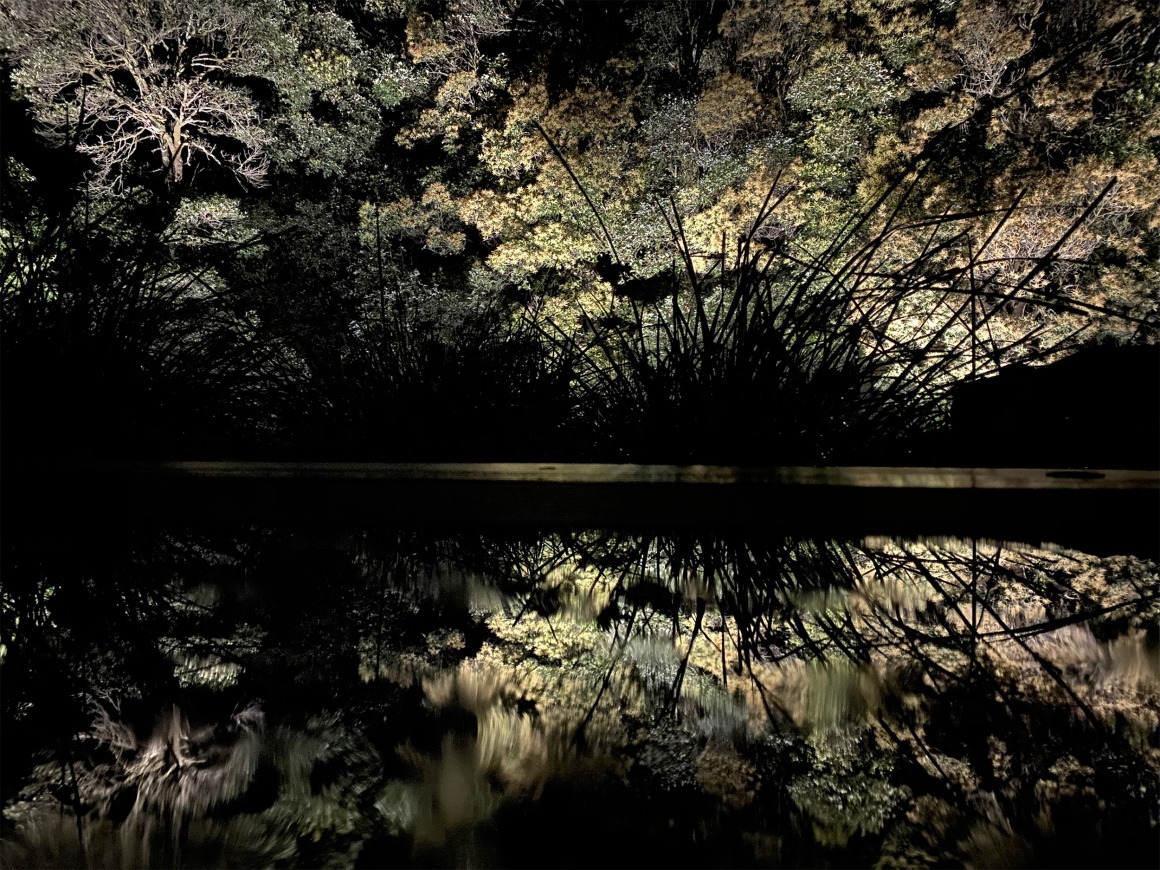
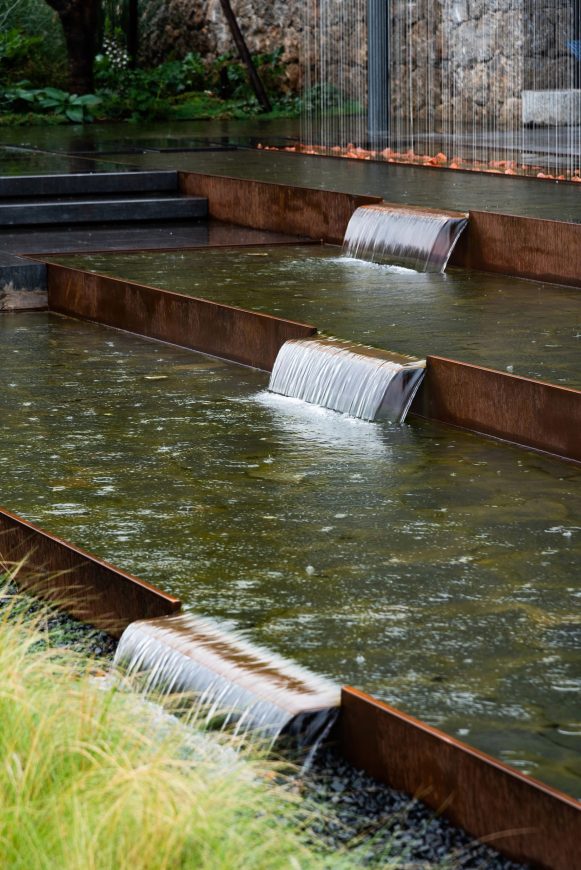
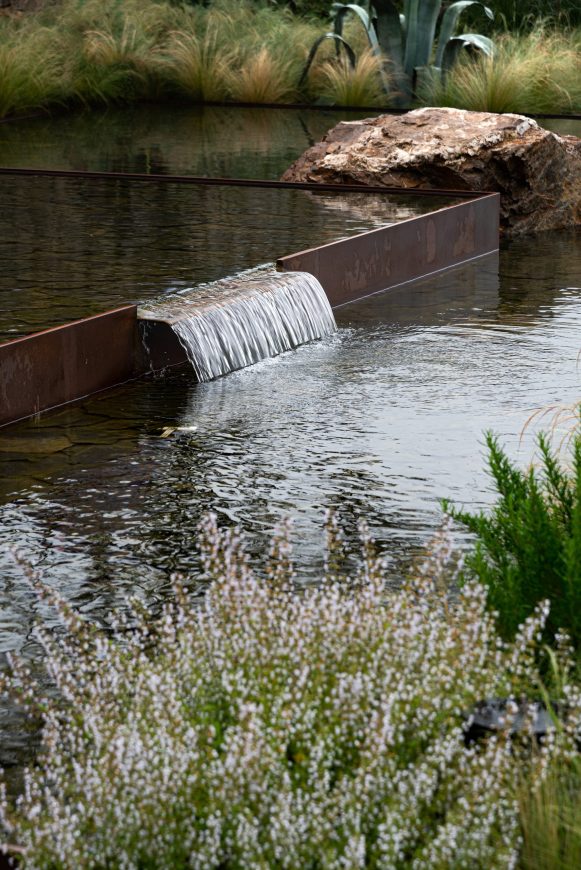
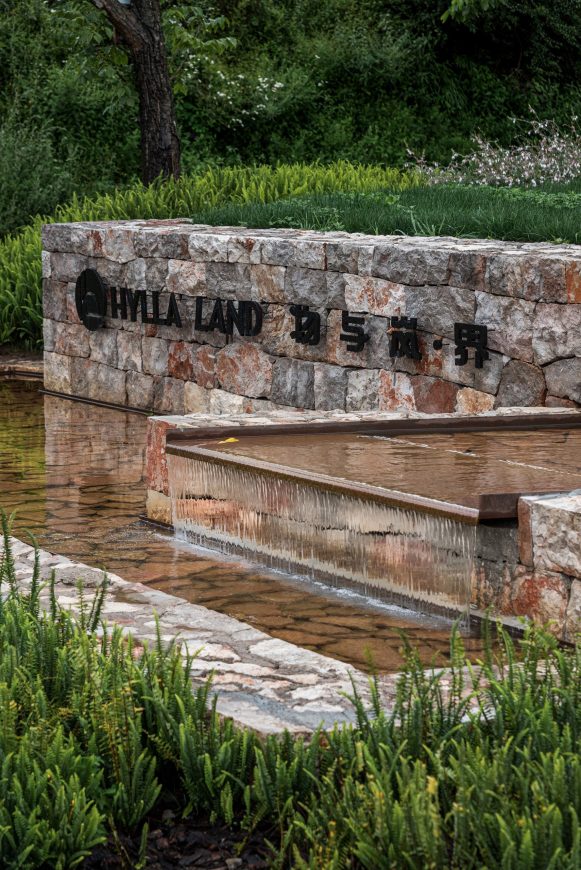
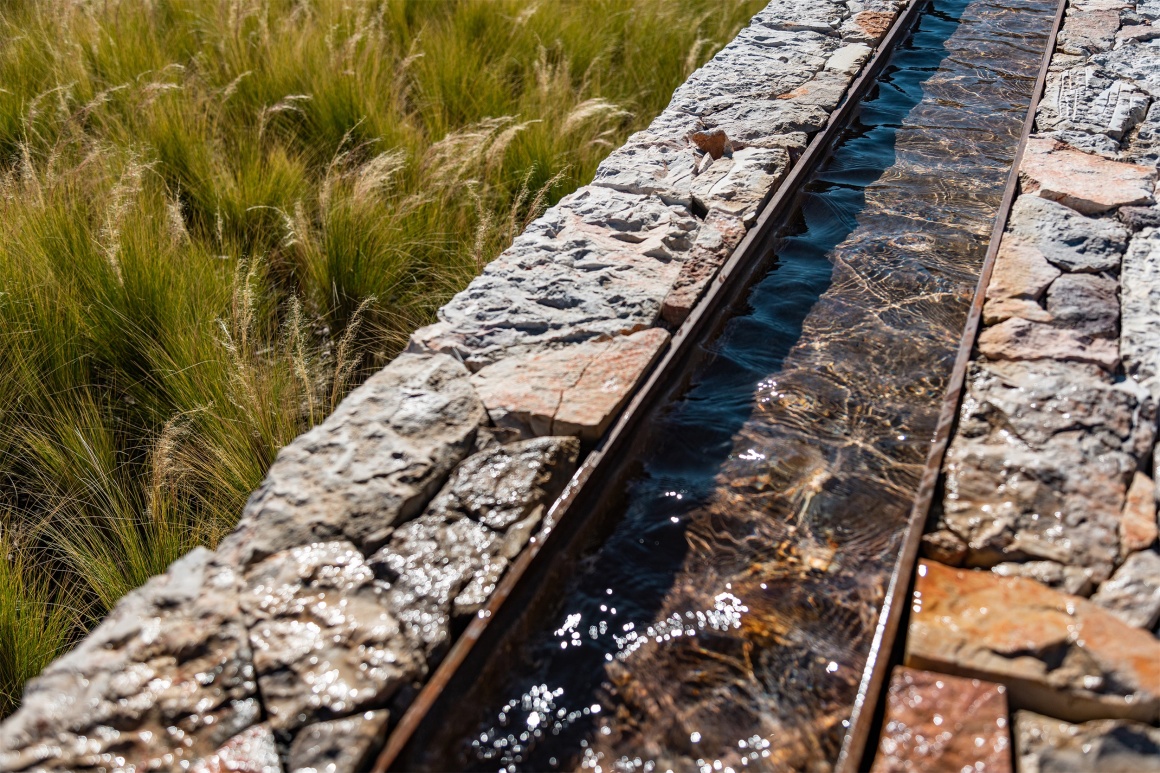
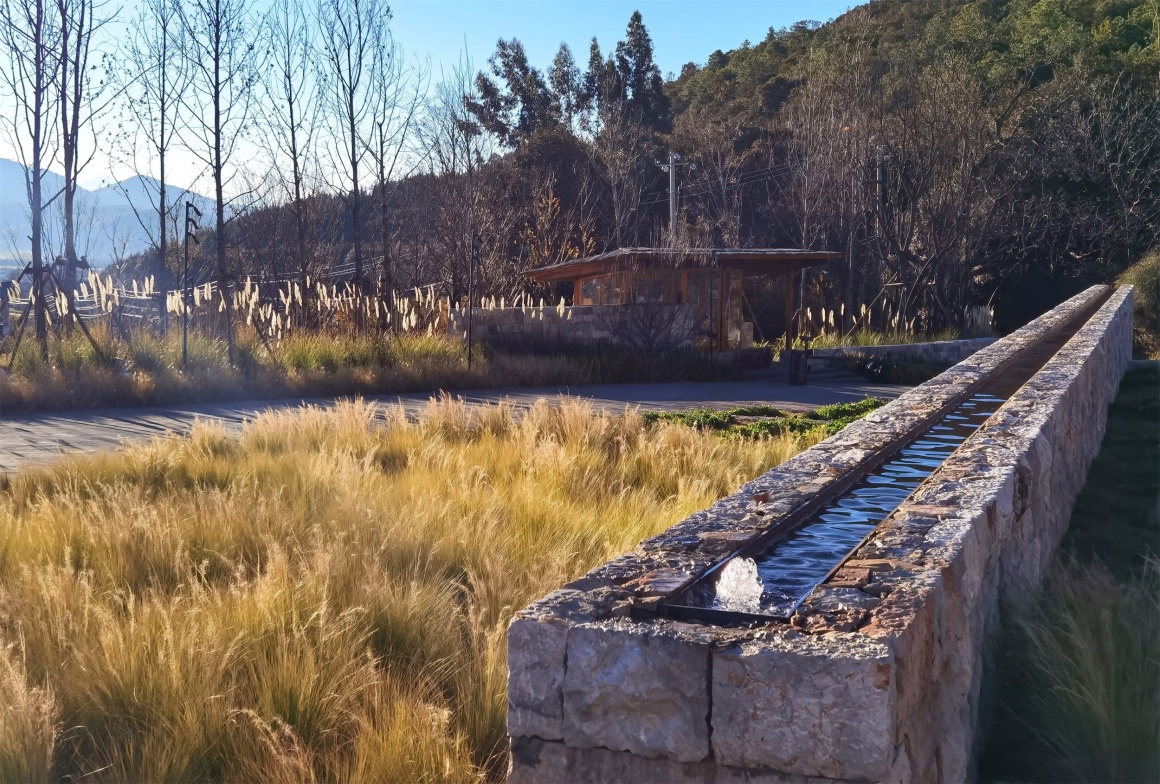



0 Comments